Planning a 9-day Ireland itinerary can be a pain in the backside… So, we’ve done all of the hard work for you!
We’ve spent 25+ years travelling around Ireland and the itinerary below leans on that experience and the many mistakes we made along the way!
In a nutshell, this 9-day itinerary:
- Starts and ends in Cork
- Has been meticulously planned
- Has an hour-by-hour itinerary for each day to save you time/hassle
- Follows logical routes that take you to hidden gems, tourist favourites and great pubs and restaurants
Who this itinerary will suit
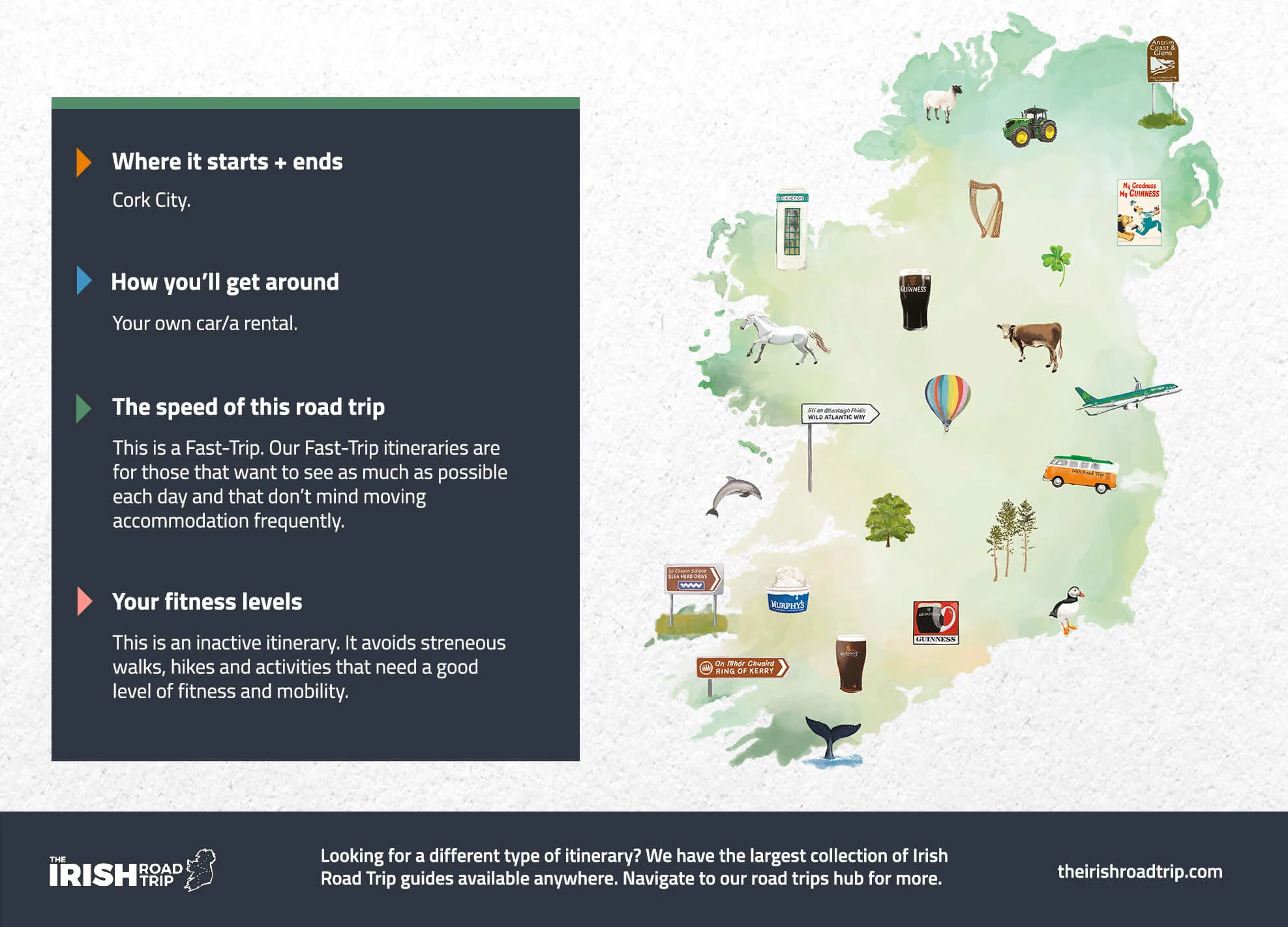
Now, before you scroll down, take 10 seconds to look at the graphic above – each of our road trip itineraries have been tailored to specific needs.
This road trip is specifically for those of you:
- Starting in/near Cork
- Using your own car/a rental
- Looking to explore at a fast pace
- With a low level of fitness (i.e. it avoids long walks and hikes)
- Remember, we have hundreds of different itineraries here if this one doesn’t suit you.
An overview of this itinerary

Click here for a high res map
The map above gives you a very high-level overview of where this route will take you.
It uses several bases (e.g. Cork for 3 nights) and provides you with day-long road trips you can head off on, so you avoid having to change accommodation constantly.
Now, I’ll stop rambling on – here’s a day-by-day insight into each of the days below!
Day 1: Cork City
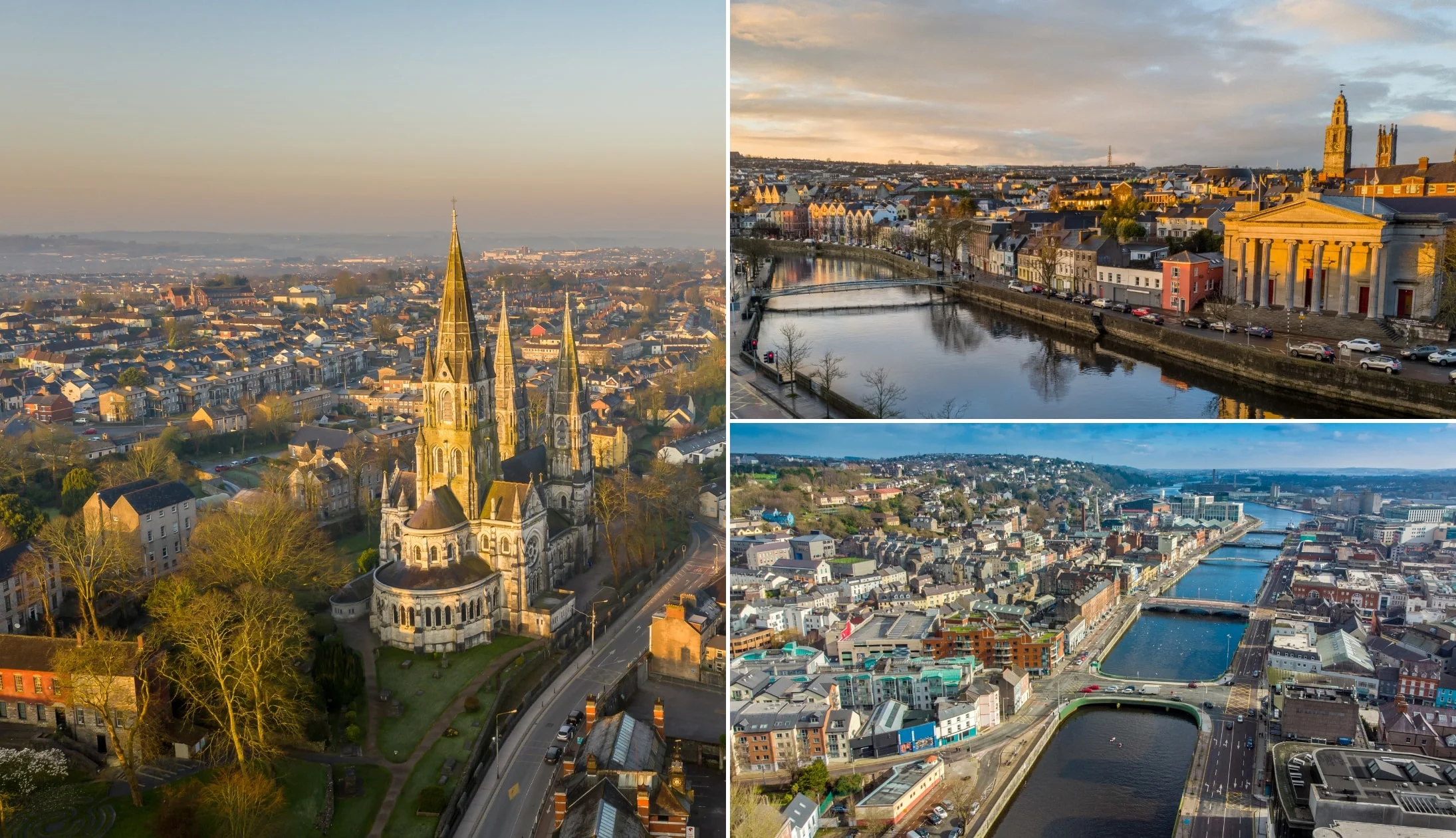
Photos via Shutterstock
Welcome to Ireland! Today, you’ve touched down in Cork City, ready to start your 9-day adventure.
You’ll be spending three nights in Cork City, and we’re going to assume that you arrived in the afternoon, so get ready for an afternoon’s worth of activities on your first day.
Recommended accommodation in Cork City
- Budget: Sheilas Tourist Hostel (no-fuss hostel near the train station) + Redclyffe Guesthouse (nice and central with great reviews)
- Mid-range: The Metropole (central with superb reviews) and Hotel Isaacs (in the Victorian Quarter – top-notch rooms and reviews)
- Luxury: Imperial Hotel (stunning and very central hotel) and Hayfield Manor (beautiful, boutique, city centre 5-star)
Stop 1: Cork City Gaol

Photo left: The Irish Road Trip. Others: Shutterstock
Cork City Gaol is our first stop of the day. It is about a 20-minute drive from the airport.
Cork City Gaol is a fascinating attraction in a castle-like building that opened in 1824 and closed in 1923. It was home to male and female prisoners who had committed crimes within the city boundaries (those who committed crimes outside were sent to the Cork County Gaol across the river).
The goal was operating through Ireland’s turbulent Civil War, housing male and female Republican (anti-treaty) prisoners, including famous Irish Author Frank O’Connor. Other famous people who were imprisoned in the gaol include Countess Markievicz, John Sarsfield Casey, James Mountaine, and Brian Dillon.
The Cork City Gaol became a museum in 1993 and is now a popular attraction in the city. You’ll learn about the prisoner’s stories, see the cells, and learn about the harsh 19th-century penal system.
Stop 2: Cork City Centre

Photos via Shutterstock
Drive into Cork City Centre and drop your bags off at your accommodation. Feel free to leave the car parked here as we will be on foot around the city.
Stop 3: Lunch
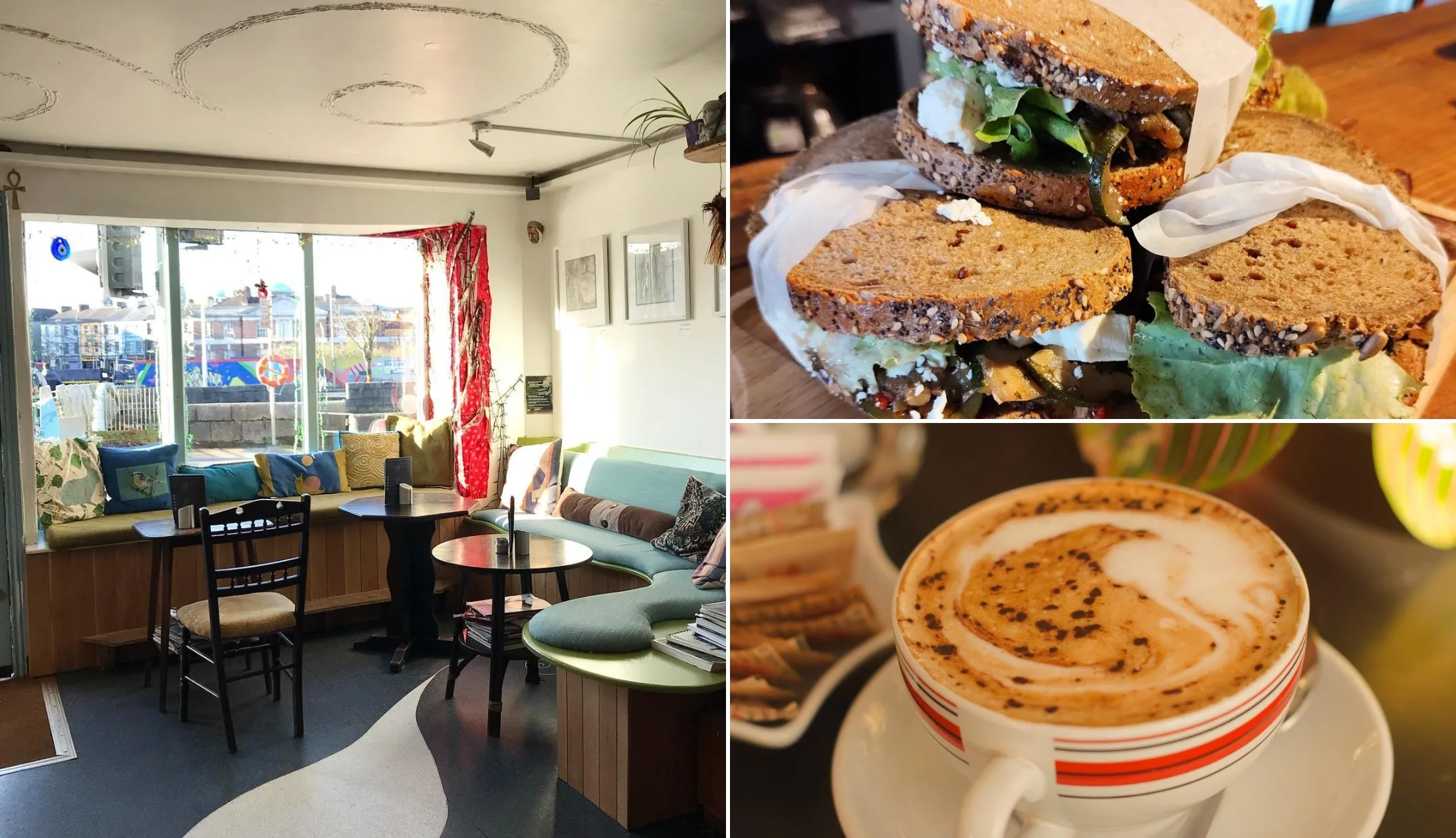
Photos via Myo Cafe on FB
Walk over to the Cornmarket for lunch. But be mindful that you’ll be heading to the English Market soon (another foodie destination), so don’t fill up too much! We recommend popping into Bodega for delicious pub grub or the Cornstore if you’re after something a little more upmarket.
Stop 4: Shandon Bell Tower

Photos courtesy Catherine Crowley via Tourism Ireland
Shandon Bell Tower is an iconic landmark in Cork City and a must-visit attraction about 10 minutes from the city centre.
The tower is a part of the Church of St. Anne, which was built in 1722. The church was built to replace an old church on the same site that was destroyed during the Seige of Cork in 1690.
You’ll need to pay a small fee to get to the top of the tower, but from the top, you’ll have wonderful views of the city, and you’ll be able to ring the bells!
Stop 5: The English Market

Photos by Chris Hill via Tourism Ireland
The English Market is 11 minutes away from Shandon Bell Tower.. It’s a beautiful covered market with impressive mid-19th-century architecture.
Its name, “English Market”, was to help distinguish it from the Cornmarket, formerly known as the “Irish Market”.
The market dates back to 1788, making it one of the oldest covered markets in Europe.
Aside from its history and beautiful architecture, the English Market is known for its delicious food, and you can get everything from artisanal olives to homemade jams.
Stop 6: Elizabeth Fort
Once you’re finished perusing the market, walk the 10 minutes over to Elizabeth Fort. The star-shaped fort dates back to the 17th century and currently sits off Barrack Street in Cork City.
The fort was originally on high ground, but over the years, the city has built up around it, although it still has fantastic views over Cork.
General admission is free, but if you’d like to learn more about this historical fortification, guided tours are offered at 1pm every day (€5), and audio guides are available in multiple languages (€3).
Stop 7: Dinner, drinks and live music
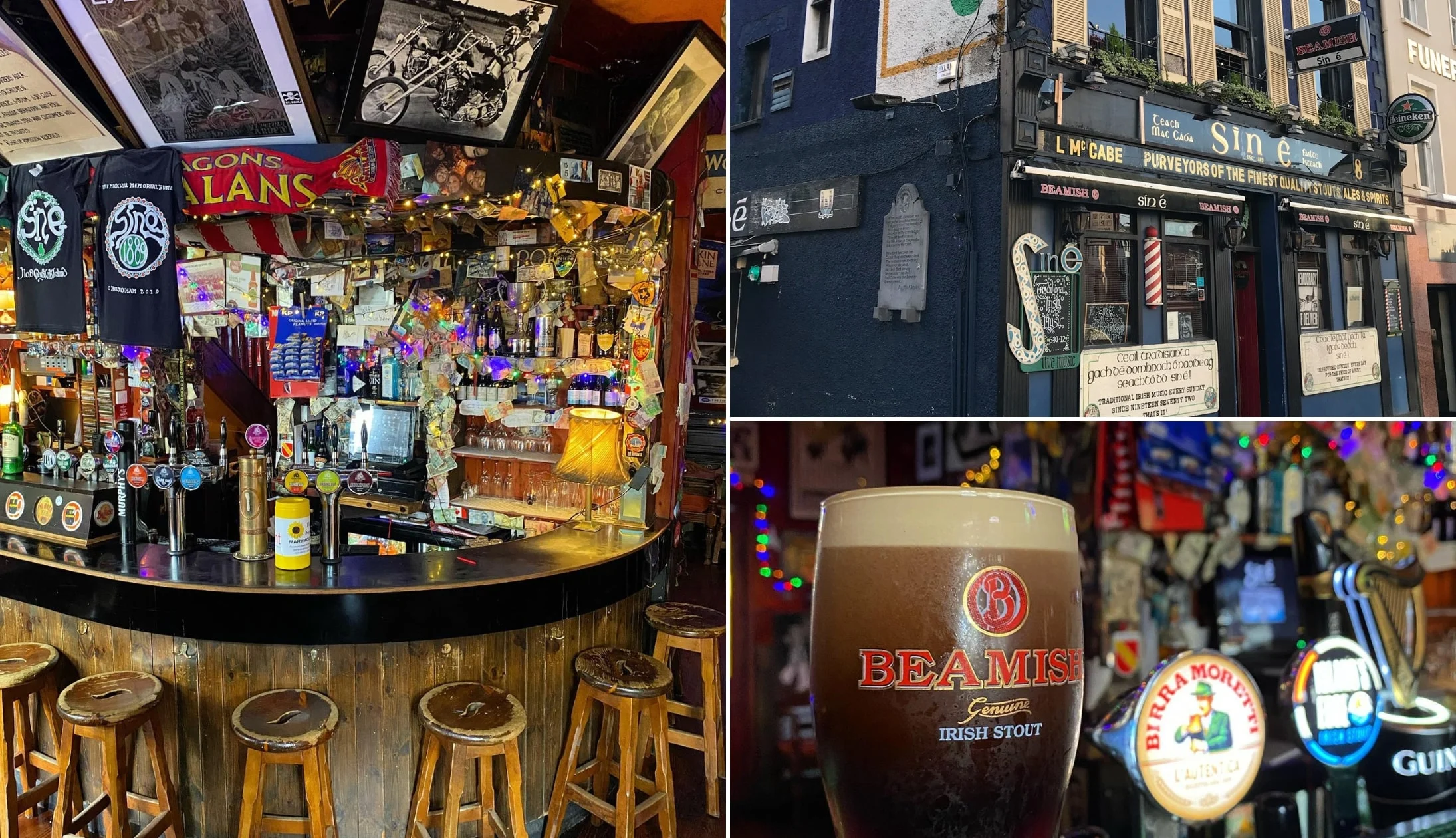
Photos via Sin E on FB
You have endless food and pub options in Cork City, regardless of what it is that you fancy on the night.
Here’s a few recommendations to get you started, but feel free to follow your nose:
Our dinner recommendations
There are heaps of brilliant restaurants in Cork City, but our personal favourites are Market Lane, Old Town Whiskey Bar at Bodega, and Cornstore.
Market Lane has a delicious-sounding menu featuring Irish favourites like pan-fried hake with braised leeks, smoked mussels, and baby potatoes, as well as international dishes like Sri Lankan vegetable curry with tempura aubergine and forbidden rice.
Head to Old Town Whiskey Bar for burgers, salads, and traditional pub grub, and Cornstore for steaks and seafood.
Live music and trad bars
There’s some might old-school pubs in Cork City, too. For drinks, check out Mutton Lane (a quirky traditional pub), The Oval (a historic pub named after its unique oval ceiling), and Castle Inn (a traditional family-run pub with a great atmosphere).
There are some great spots for hearing some trad music in Cork, our top choices are Sin E and The Corner House.
Day 2: Blarney and Cobh

Photos via Shutterstock
It’s day 2 of your 9 days in Ireland, and today you’re going to visit Blarney Castle, where you will have the chance to kiss the Blarney Stone! Then, you continue out to Cobh, the last stopping point of the Titanic.
Today, you’re also going to visit Spike Island on the 12 o’clock boat, so make sure to start the day early so you’ll arrive in time for the boat!
Before you head out, grab some breakfast at your accommodation, Gusto, or head to the English Market to find somewhere to eat.
Stop 1: Blarney Castle and Gardens

Photos via Shutterstock
The Blarney Castle and Gardens are a 19-minute drive from Cork City, and we’d recommend spending at least 3 hours here to explore.
Of course, the main draw is the Medieval castle and the infamous Blarney Stone (make sure you kiss it to get the gift of the gab!). But the gardens are also fantastic.
There’s the eerie Witch’s Kitchen, the Druid Circle, and the Poison Garden to discover, as well as the Board Walk and Water Garden and the Vietnamese Woodland.
Stop 2: Lunch in Cobh
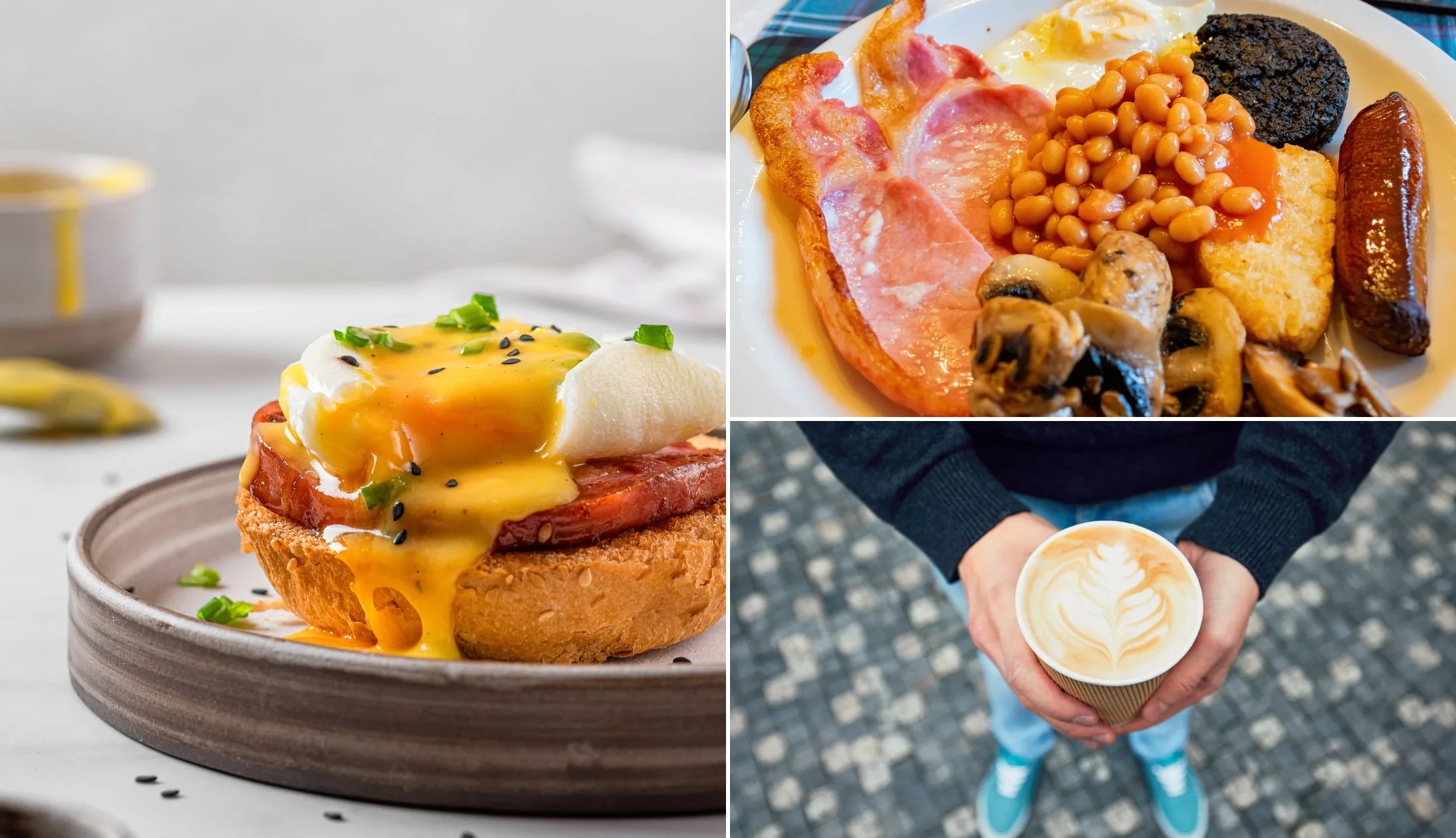
Photos via Shutterstock
After kissing the Blarney Stone, you must be getting hungry. Our next stop is Cobh, the last stopping point of the Titanic, which is a 40-minute drive away.
Get yourself a well-deserved lunch at the Seasalt Cafe or O’Sheas Bar, a couple of our favourites.
Stop 3: Spike Island

Photos cCourtesy Spike Island Management via Tourism Ireland
Head to the pier right in the centre of Cobh before 12pm to catch the boat to Spike Island. The fort/prison is an impressive place, and you’ll be spending around 3 hours here.
There’s a short free tour at the beginning of the trip, which is open to all. We highly recommend joining as you’ll learn lots of interesting facts about the island.
Spike Island has a really colourful history, and over the years, it’s worn many hats.
During its 1,300-year history, the island has been home to a monastery, a fortress, and a notorious prison for Republican prisoners captured in the Irish War of Independence.
Stop 4: St. Coleman’s Cathedral

Photos via Shutterstock
After your trip out to Spike, if you have the time (and energy) to walk up the hill to the cathedral, we highly recommend you do so. It’s a lovely building, and the views over Cork Harbour are wonderful. It’s a bit of a slog up the hill, but it’s worth it!
Cobh Cathedral, or St. Coleman’s Cathedral, is one of Cobh’s iconic landmarks. It’s a gorgeous cathedral with large stained-glass windows, intricate carvings, and an impressive 90-metre spire that dominates the town’s skyline.
It took 51 years from the first cornerstone being laid to the cathedral’s consecration. Building the cathedral was a mammoth project and cost well over the initial budget. It’s just as beautiful on the inside as it is from the outside, with large stone arches, pillars, and red marble shrines.
Stop 5: Back to Cork City for the night

Photos via Sin E on FB
It’s time to head back to Cork City for dinner, so jump in the car and drive the 30 minutes back.
You have endless food and pub options in Cork City, regardless of what it is that you fancy on the night.
Here’s a few recommendations to get you started, but feel free to follow your nose:
Our dinner recommendations
There are heaps of brilliant restaurants in Cork City, but our personal favourites are Market Lane, Old Town Whiskey Bar at Bodega, and Cornstore.
Market Lane has a delicious-sounding menu featuring Irish favourites like pan-fried hake with braised leeks, smoked mussels, and baby potatoes, as well as international dishes like Sri Lankan vegetable curry with tempura aubergine and forbidden rice.
Head to Old Town Whiskey Bar for burgers, salads, and traditional pub grub, and Cornstore for steaks and seafood.
Live music and trad bars
There’s some might old-school pubs in Cork City, too. For drinks, check out Mutton Lane (a quirky traditional pub), The Oval (a historic pub named after its unique oval ceiling), and Castle Inn (a traditional family-run pub with a great atmosphere).
There are some great spots for hearing some trad music in Cork, our top choices are Sin E and The Corner House.
Day 3: Kinsale

Photos via Shutterstock
Today you are exploring the coastal area just south of Cork City and the village of Kinsale. There’s a bit of walking today between attractions, so make sure to wear suitable footwear and bring plenty of water.
Grab some breakfast at your accommodation or nearby before heading out. Farmgate and Cafe Spresso do a good breakfast.
Stop 1: Garretstown and Garrylucas Beach

Photos via Shutterstock
You are going to start the day with a walk along some beaches. Garretstown is 50 minutes outside of Cork. You actually drive through Kinsale on your way there so you will get a sneak peek of what’s in store for the rest of the day!
Park at Garretstown and walk along the beach or the path above the beach, around the head and then over to Garrylucas Beach.
Both of the beaches have great views, public toilets and are popular with surfing and kiteboarding so there can be a lot going on, making them great for some people watching.
Stop 2: Lusitania Museum

Photos courtesy Shannon Forde via Failte Ireland
The Lusitania Museum is a 7-minute drive from the beach. It’s inside an old Signal Tower, The Old Head Signal Tower, one of 81 built from Dublin to Donegal. The ground floor of the tower tells the story of Ireland’s Signal Towers and the area’s ancient history.
On the first floor, you’ll find exhibitions and artefacts relating to the RMS Lusitania, which was tragically torpedoed by a German U Boat during WWI. The boat sank in only 18 minutes, resulting in many casualties.
Once you’ve learned the story of the RMS Lusitania, head outside to the Lusitania Memorial Garden to look at the powerful 20-metre sculpture which includes the names of the lives lost on May 7th, 1915. There are also beautiful views over Kinsale Head.
Stop 3: Kinsale

Photos via Shutterstock
Hop in the car and drive 18 minutes to Kinsale. You’ll find parking in the centre of the village here.
We recommend parking here, exploring the town and then picking up the car to head to Charles Fort.
Stop 4: St. Multose Church

Photos via Shutterstock
Stroll 5 minutes up to St. Multose Church, thought to be one of the oldest churches belonging to the Church of Ireland! It’s a cruciform church with a crypt that dates back to 1190, although the entire church is built on a 6th-century ecclesiastical settlement.
In the 1750s, the church underwent major additions. However, the church’s large bell tower is a part of the original Norman structure. The church’s graveyard contains 16th-19th-century monuments and mausoleums, as well as the graves of unidentified victims of the RMS Lusitania sinking.
Stop 5: Cosy Cafe and explore Kinsale

Photos via Shutterstock
If you’re ready for a mid-morning coffee, head into the Cosy Cafe across the street from St. Multose Church.
You’ve got a little time for a wander if you feel like it, so why not take your coffee to go and explore the gorgeous town of Kinsale?
You can pass by Desmond Castle (it’s most likely closed by you can admire it from the outside), pick up a book from Bookstór (a lovely independent bookstore selling new and second-hand books), or do some shopping in one of the town’s boutique shops.
Stop 6: Lunch at The Bulman
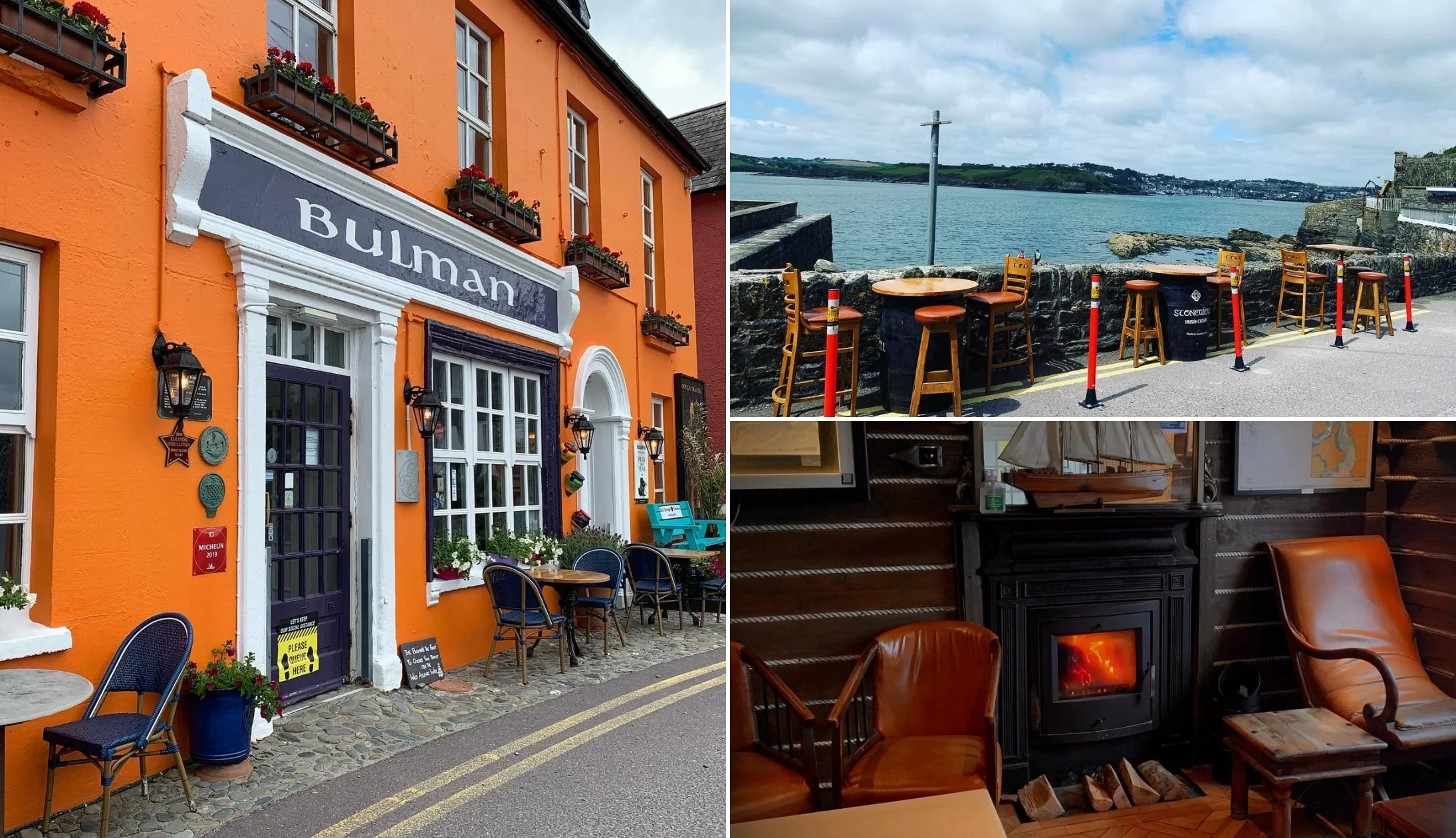
Photos via the Bullman on FB
Grab the car and take the short spin to the Bullman – there’s a car park right across from it.
The Bullman is a wonderful restaurant right next to an idyllic little harbour.
They have a varied menu, with everything from Thai green chicken curry, to local BBQ pork ribs with wasabi slaw. Since it’s one of the last days of your trip, consider treating yourself to grilled lobster, a customer favourite!
The roads to The Bullman from Charles Fort are quite narrow, so we recommend leaving the car at the fort and enjoying the five-minute stroll to the fort.
Stop 7: Charles Fort

Photos via Shutterstock
Walk 5-minutes past the Bullman to get to Charles Fort.
Charles Fort is the country’s largest military installation. The huge star-shaped building dates back to the late 17th century, and over the years, has seen some fearsome battles.
The fort survived a 13-day siege during the Williamite wars in 1690 and a battle during the Civil War in the 1920s. Make sure to head to the ramparts for the stunning view over Kinsale Harbour.
Stop 8: Back to Cork City for the night

Photos via Sin E on FB
Head back to Cork City for the evening, the drive usually takes around 30 minutes from central Kinsale.
You have endless food and pub options in Cork City, regardless of what it is that you fancy on the night.
Here’s a few recommendations to get you started, but feel free to follow your nose:
Our dinner recommendations
There are heaps of brilliant restaurants in Cork City, but our personal favourites are Market Lane, Old Town Whiskey Bar at Bodega, and Cornstore.
Market Lane has a delicious-sounding menu featuring Irish favourites like pan-fried hake with braised leeks, smoked mussels, and baby potatoes, as well as international dishes like Sri Lankan vegetable curry with tempura aubergine and forbidden rice.
Head to Old Town Whiskey Bar for burgers, salads, and traditional pub grub, and Cornstore for steaks and seafood.
Live music and trad bars
There’s some might old-school pubs in Cork City, too. For drinks, check out Mutton Lane (a quirky traditional pub), The Oval (a historic pub named after its unique oval ceiling), and Castle Inn (a traditional family-run pub with a great atmosphere).
There are some great spots for hearing some trad music in Cork, our top choices are Sin E and The Corner House.
Day 4: Goungane Barra and Bantry
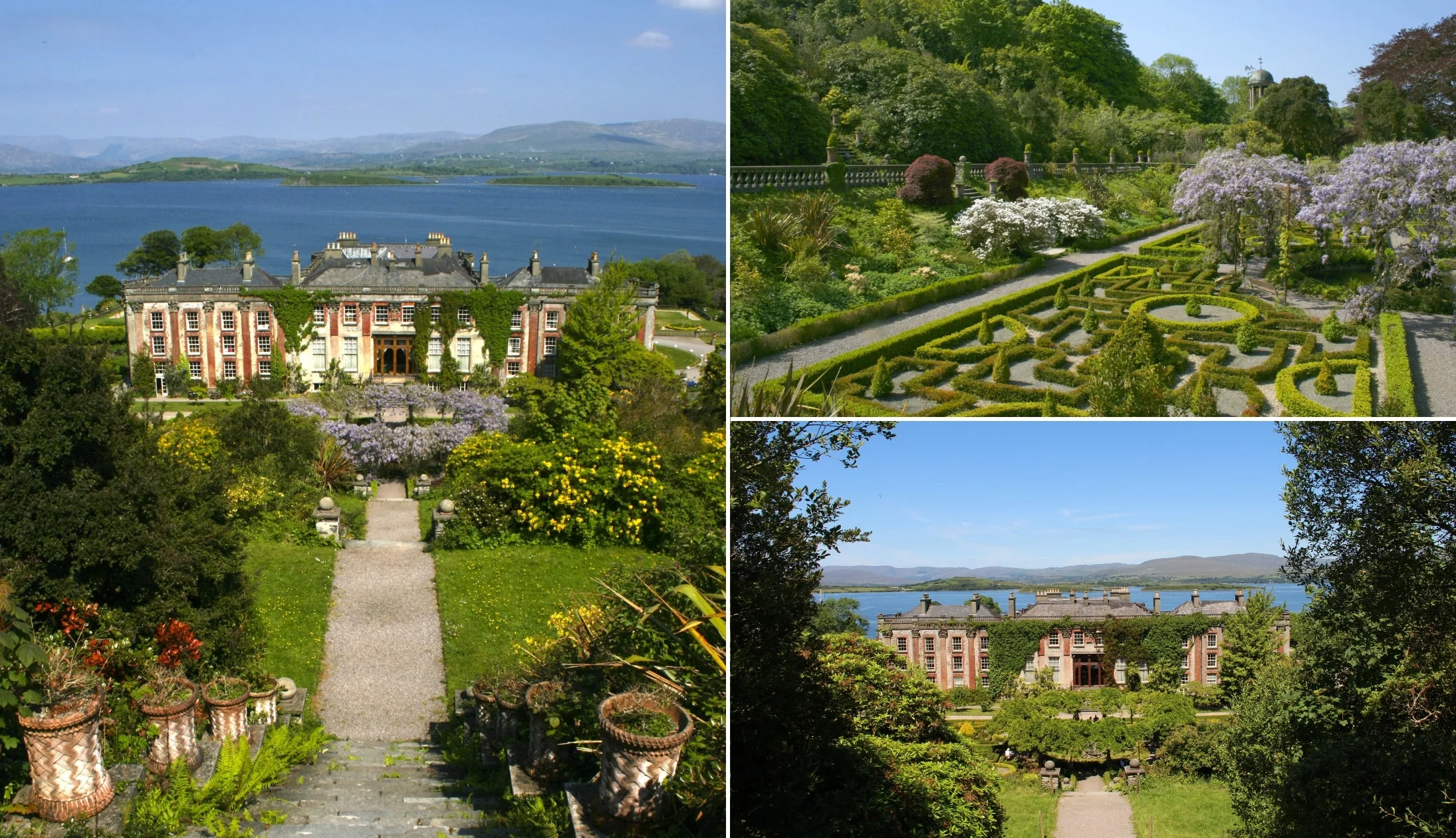
Photos via Shutterstock
It’s time to wave goodbye to Cork City, and today, you’re making your way to Bantry in West Cork, where you’ll be spending two wonderful nights.
Before you hit the road, grab a hearty breakfast at your accommodation before check out, or stop at Filter or Alchemy for some top-notch coffee and some pastries for the drive.
Bantry is a picturesque little market town on the shores of Bantry Bay.
Recommended accommodation in Bantry
- Budget: Bru Na Pairc B&B (homely B&B about a 15-minute walk from the town) and Niblick (gorgeous guesthouse a 5-minute drive from the town)
- Mid- Range: The Maritime: (central hotel with great reviews) and Westlodge Hotel (popular spot just outside of town)
- Luxury: Seaview House Hotel (beautiful old-world hotel a 7-minute drive from town)
Stop 1: Gougane Barra

Photos via Shutterstock
Your first stop of the day is Gougane Barra, a beautiful and peaceful spot around one hour and 10 minutes from Cork City.
It’s home to some brilliant walks if you feel like stretching your legs a bit, but we’d mostly recommend just walking around the little church (which is probably the most scenic in Ireland) and the stations of the cross.
The whole valley is beautiful and if you’re into novel attractions, the Gougane Barra public toilet is known as the most beautiful toilet in Ireland and is featured in a book of the best toilets in the world!
Stop 2: Bantry

Photos via Shutterstock
Make your way to the bustling town Bantry, a handy 27-minute drive away and, if you can, check into your accommodation.
When you’re ready to rock, we’ve some solid recommendations for a lunchtime feed!
Stop 3: Lunch
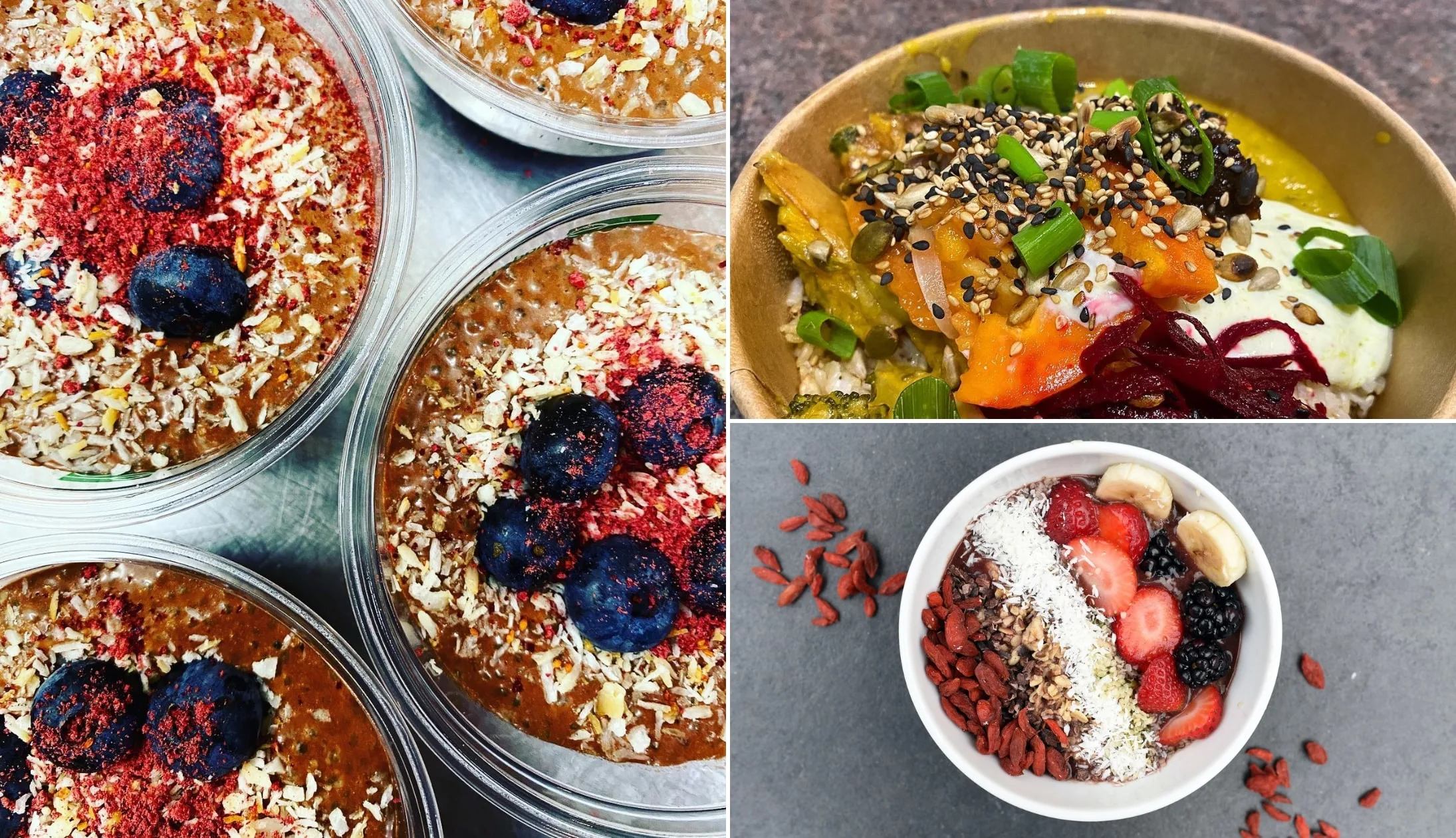
Photos via Organico on FB
We recommend stopping by Organico (there’s no seating as it’s technically a deli, but they have some deliciously healthy salads and sandwiches), Donemark West (beautifully presented plates and the steaks are a hit!), or The Brick Oven (tasty brick-oven pizzas).
Stop 4: Bantry House

Photos via Shutterstock
Few places in Ireland are as fairytale-like as the stunning Bantry House and Gardens.
This gorgeous 18th-century mansion stands proudly overlooking Bantry Bay, nestled amongst some beautifully manicured grounds.
It’s possible to do a self-guided tour of the home and its elegantly restored rooms, but it’s worth visiting for the gardens and magnificent views alone.
Stop 5: Garnish Island
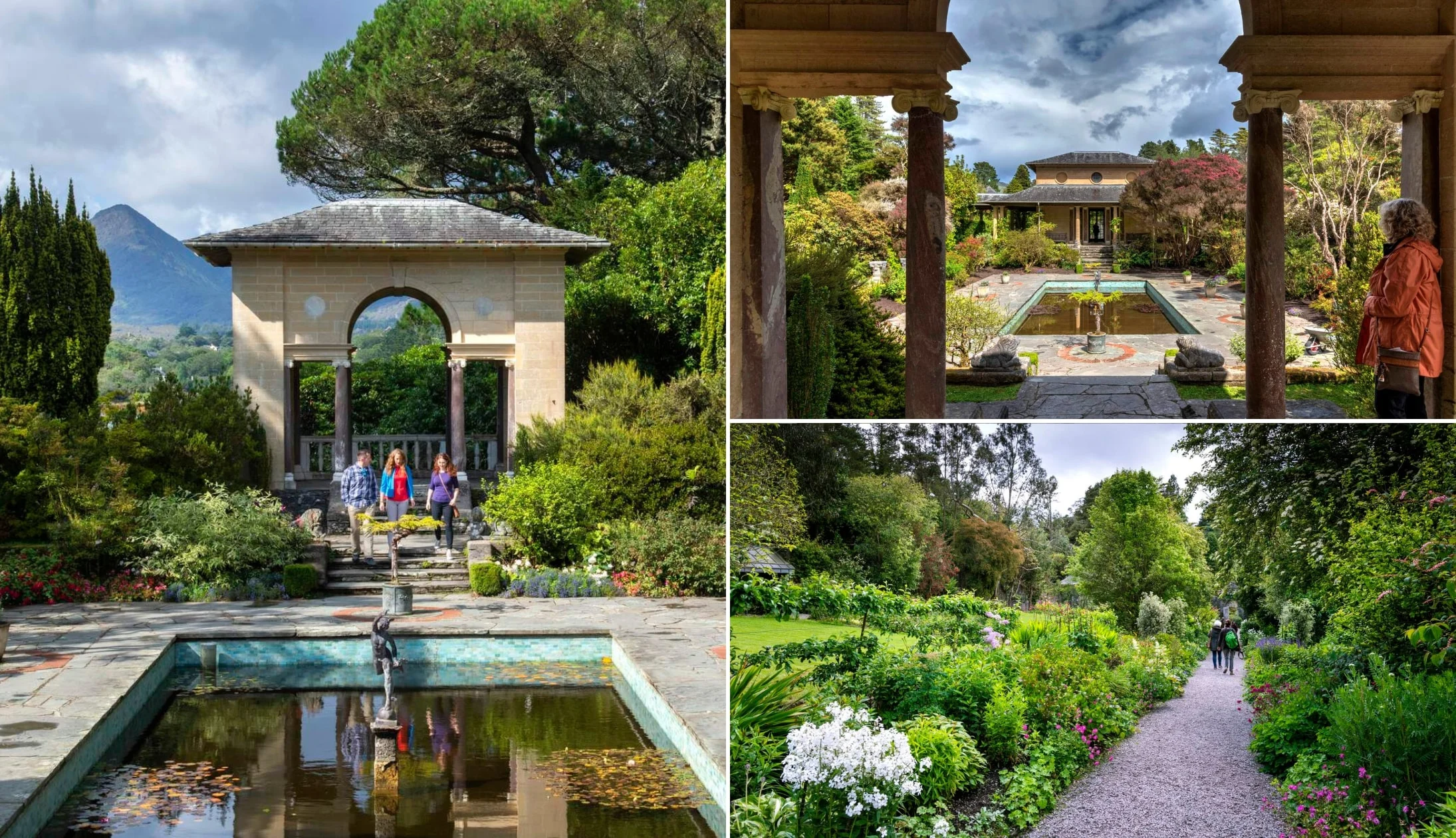
Photos by Chris Hill via Tourism Ireland
Our next stop of the day takes us a 20-minute spin up the road to the gorgeous town of Glengarriff to take the ferry over to Garnish Island.
The ferry takes around 10-15 minutes and it transports you to an almost tropical-like island that’s like something from another world.
Expect seemingly never-ending gardens, glorious views and gentle trails. Make sure to book your tickets in advance (info here).
Stop 6: Dinner, drinks and live music in Bantry
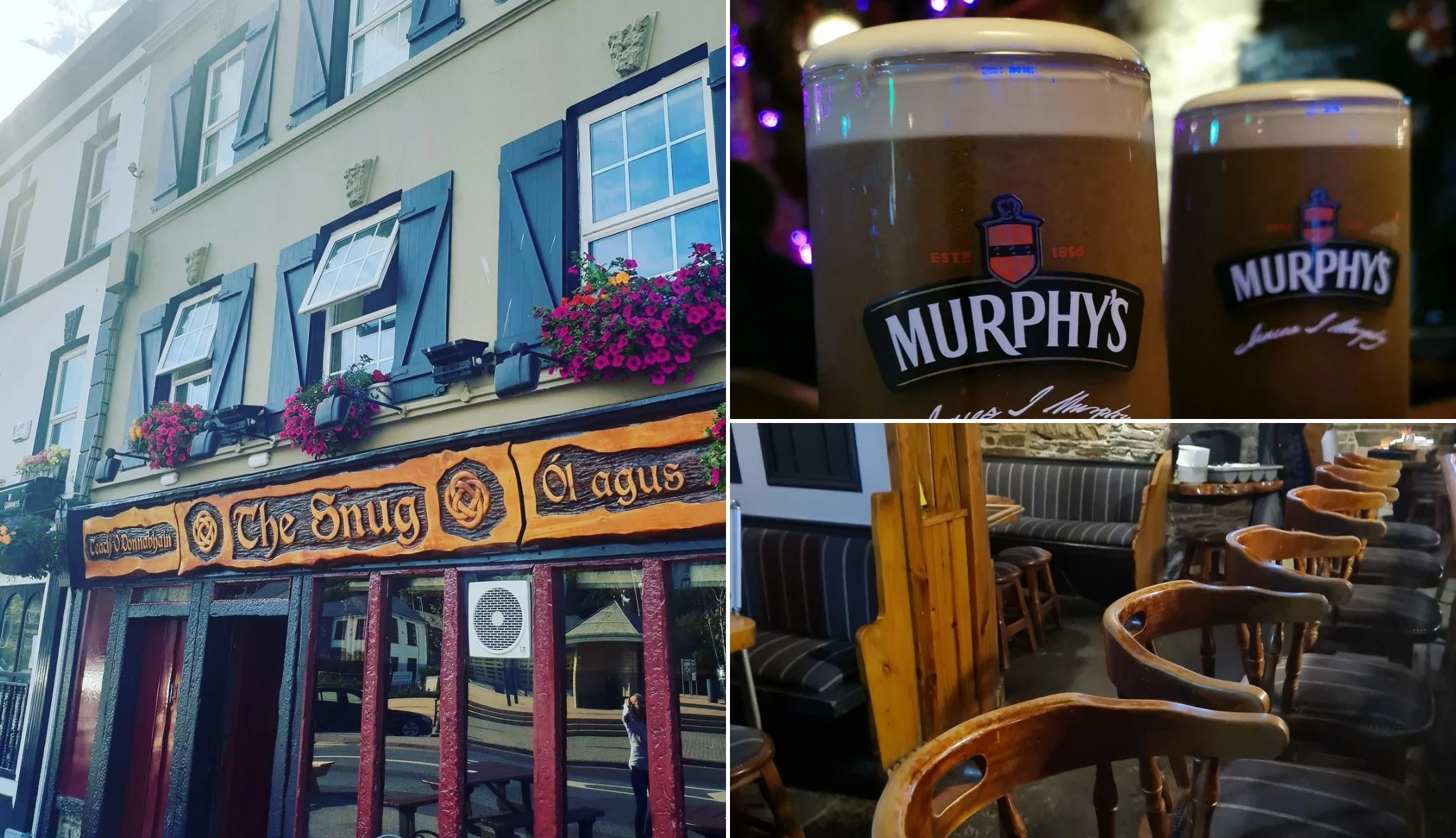
Photos via The Snug on FB
After your trip to Garnish, take the ferry back to shore and head back to Bantry for the night.
Our dinner recommendations
Bantry has lots of great places to eat, but our go-to’s are The Snug and O’Connor’s Seafood Restaurant.
The Snug is hard to miss with its amazing historical exterior and central location near the town square. You’ll find traditional Irish dishes like slow-roasted lamb shank and fish and chips, that wash down well with a pint of Guinness.
O’Connors Seafood Restaurant is a must-try for anyone who loves seafood. It has been featured in the Michelin Guide plus they source their produce and ingredients locally.
Live music and trad bars
For after-dinner drinks, we suggest popping into Ma Murphy’s (a fourth-generation Irish pub, full of charm with a lovely beer garden), The Quays (another traditional Irish pub which we recommend if you’re looking to catch a sports game), and Anchor Tavern (an old-school Irish pub with traditional decor and a cosy atmosphere).
Head to any of the above for some live music. Ma Murphy’s also sometimes puts on events and singing sessions.
Day 5: West Cork’s wonders

Photos via Shutterstock
Today, you’re making your way to the most southerly point in Ireland, Mizen Head. Along the way, you’ll be exploring some lovely little villages called Skibbereen, Schull, and Crookhaven.
But first, start the day with some breakfast where you’re staying or head out into Bantry to find somewhere. We love the Floury Hands Bakery Cafe (open from 8:30am).
Stop 1: Skibbereen Town and Hertitage Centre
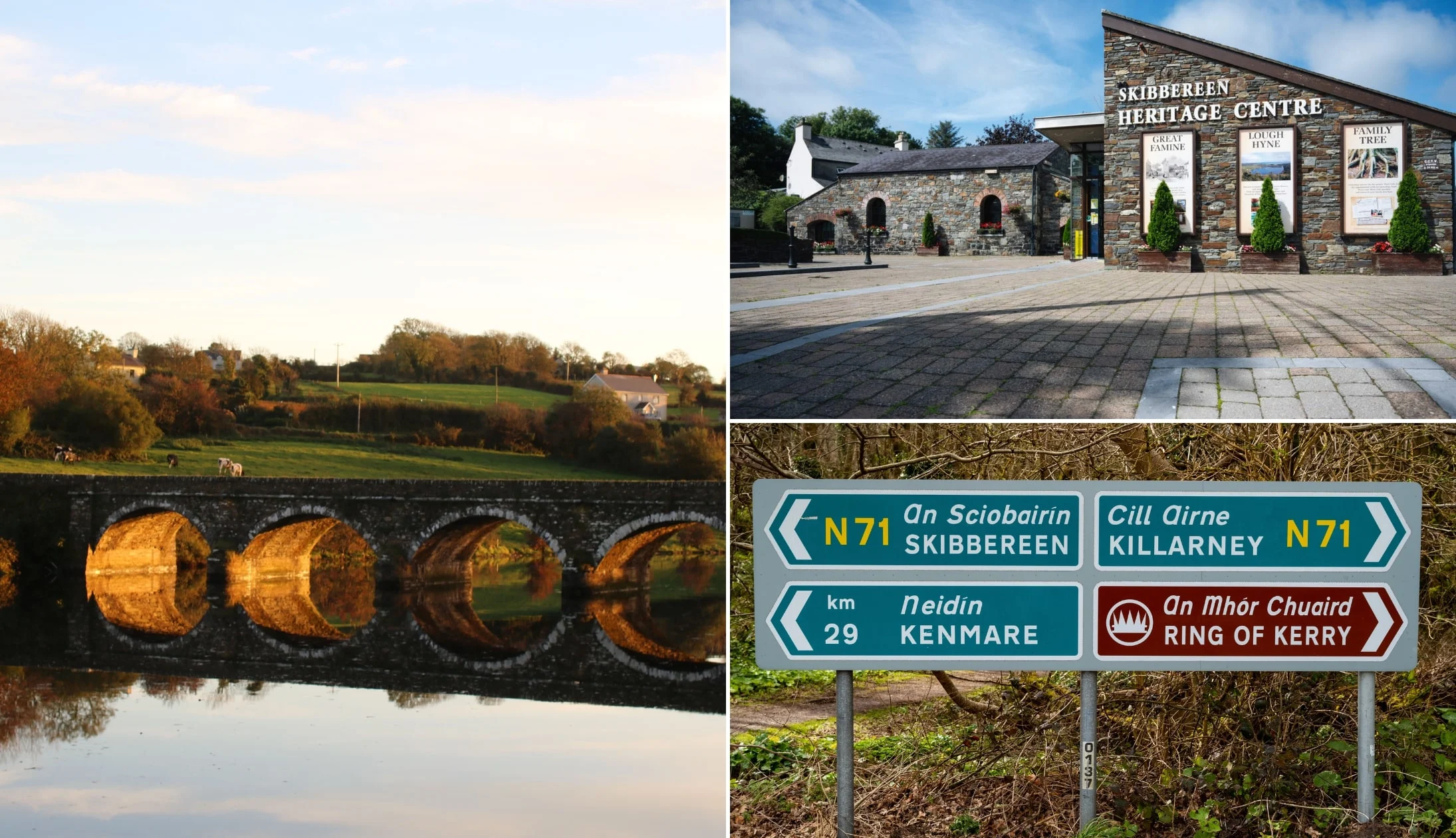
Top right photo: Tourism Ireland. Others: Shutterstock
Your first stop of the day is the Skibbereen Heritage Centre, a 25-minute drive from Bantry.
Although the Great Famine affected most of Ireland, Skibbereen was hit particularly hard. The heritage centre tells Skibbereen’s famine story through an interactive famine exhibit.
The centre also has an interesting exhibit on nearby Lough Hyne, the first marine nature reserve in the country.
Stop 2: Lough Hyne
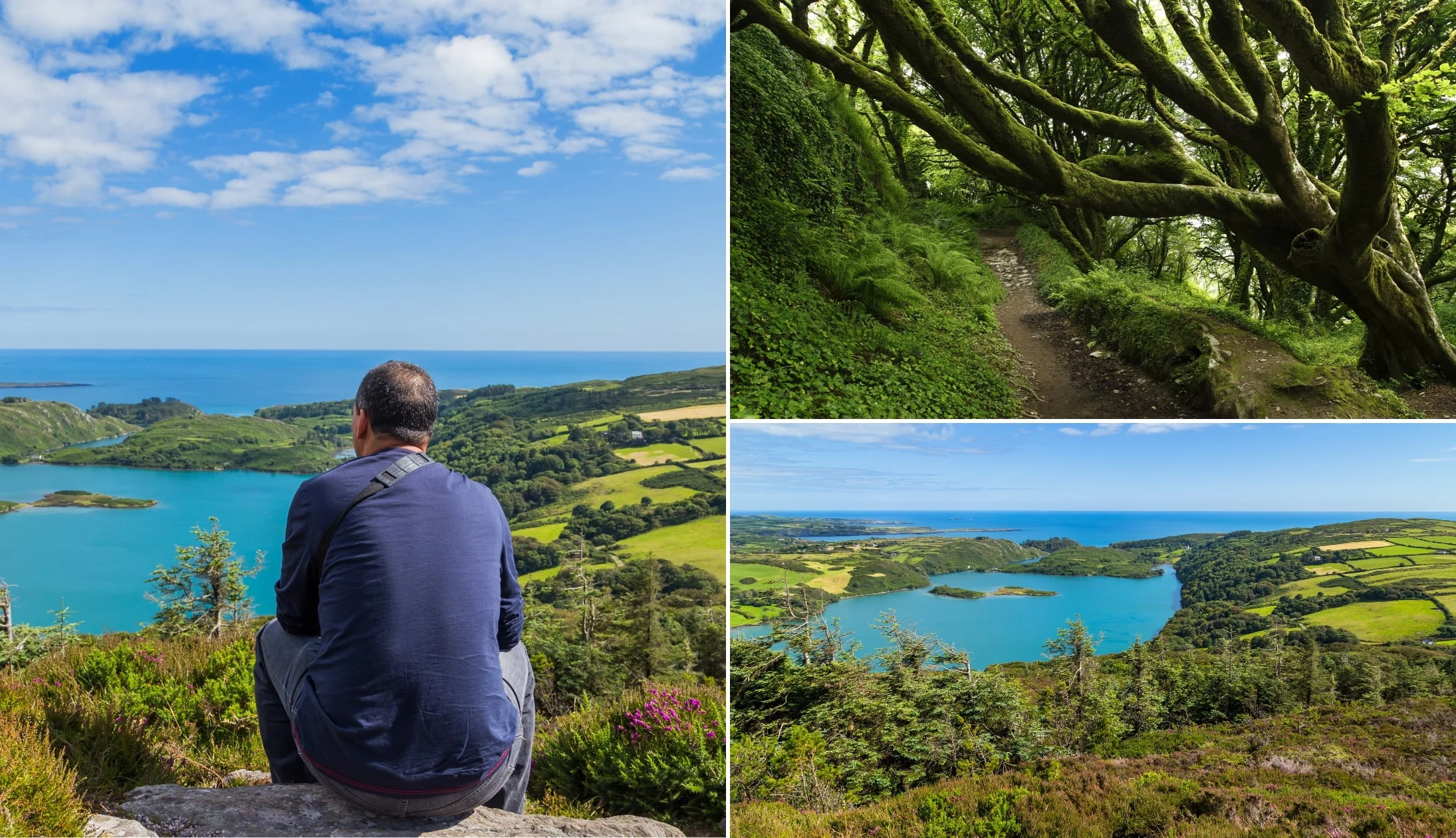
Photos via Shutterstock
Lough Hyne is 12 minutes away from the heritage centre. It’s a really beautiful spot and there are lots of walks (short and long) in the area.
Our favourite walk is the one up Knockomagh Woods, it starts in the car park, continues up through the woodland, and onto the top of the hill, where you’ll have unbeatable views of the seawater lake! Give yourself 45 minutes to reach the top.
If a steep climb isn’t what you’re after, then you could always head off on a short and sweet ramble along the shore.
Stop 3: Schull for coffee and a stroll

Photo left: Shutterstock. Others: Chrish Hill via Failte Ireland
22 minutes from Skibbereen, you’ll find the wonderful village of Schull in West Cork! It’s a fantastic spot for a short stroll by the pier and along the peaceful waterfront.
If it’s about time for a mid-morning cup of coffee, we suggest popping into Nickie’s Kitchen so you can enjoy a cup as you wander through the village.
Stop 4: Altar Wedge Tomb

Photos via Shutterstock
Your next stop, the Altar Wedge Tomb, is a 7-minute drive from Schull. Also called ‘Tuama Dingeach na hAltora’, this monument dates back to around 2,500 BC – 2000 BC (between the late Neolithic and early Bronze Age).
It was a site used for cremated burials and pit burials. Interestingly, when it was excavated in 1989, archaeologists found fishbones, periwinkles, and limpets alongside human bones. Presumably, these were part of the ancient burial ritual.
The tomb sits near the edge of a cliff close to Toormore Bay, with breathtaking views of the ocean, nearby islets, and surrounding countryside. You’ll find a small car park nearby here.
Stop 5: Lunch in Crookhaven
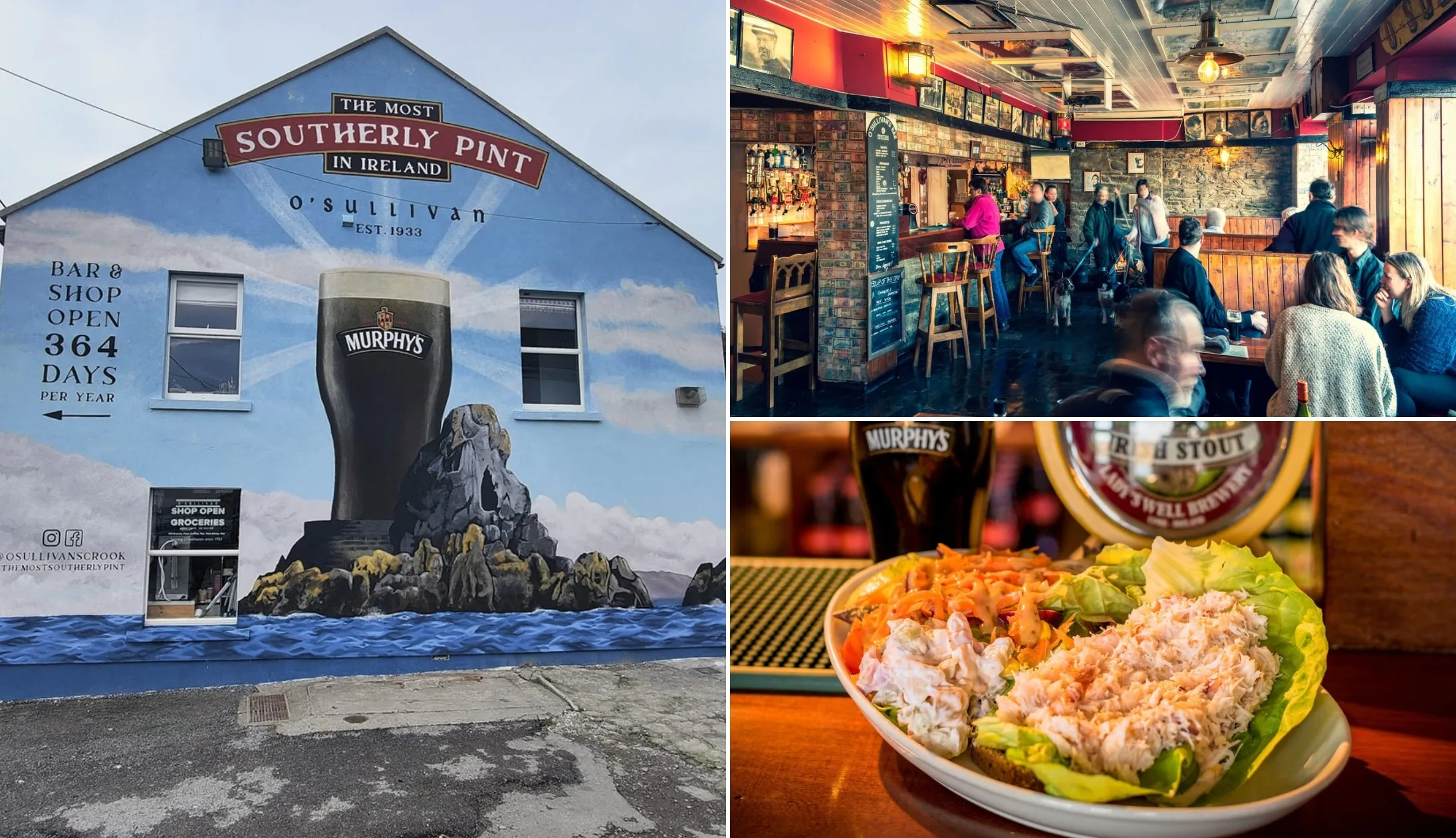
Photos via O’Sullivan’s on FB
It’s time for lunch in the beautiful little fishing village of Crookhaven, a 19-minute drive away, and one of our favourite places in West Cork! We always pop into either O’Sullivan’s Bar or the Crookhaven Inn for a bite to eat.
Both are great choices if you’re after some classic pub grub. O’Sullivan’s Bar has a delicious seafood chowder, and if the weather’s nice, they have some seats outside overlooking the harbour.
The Crookhaven Inn is another harbourside spot, with some outdoor seating and a tasty open-faced crab sandwich.
Stop 6: Mizen Head

Photos via Shutterstock
This is one of the most popular places to visit in West Cork (and for good reason!). You’ll find Mizen Head 20 minutes from Crookhaven, right on the tip of the Mizen Head Peninsula.
The landscape is wild and rugged, characterized by jagged cliffs that plunge down into the roaring Atlantic.
Aside from the spectacular views, Mizen Head is home to the Mizen Head Visitor Centre (an award-winning Maritime Museum), the historical Signal Station, and the Mizen Head footbridge, which links the mainland to Cloghane Island.
There are some wonderful viewpoints in the area, so if you feel up to some exploring, we recommend checking a few of them out. You can find out more about the different cliff paths and viewpoints here on the Mizen Head website.
Stop 7: Back to Bantry for the night

Photos via The Snug on FB
Make your way back to Bantry for the evening. It’s a 50-minute drive from Mizen Head through some lovely scenery.
Our dinner recommendations
Bantry has lots of great places to eat, but our go-to’s are The Snug and O’Connor’s Seafood Restaurant.
The Snug is hard to miss with its amazing historical exterior and central location near the town square. You’ll find traditional Irish dishes like slow-roasted lamb shank and fish and chips, that wash down well with a pint of Guinness.
O’Connors Seafood Restaurant is a must-try for anyone who loves seafood. It has been featured in the Michelin Guide plus they source their produce and ingredients locally.
Live music and trad bars
For after-dinner drinks, we suggest popping into Ma Murphy’s (a fourth-generation Irish pub, full of charm with a lovely beer garden), The Quays (another traditional Irish pub which we recommend if you’re looking to catch a sports game), and Anchor Tavern (an old-school Irish pub with traditional decor and a cosy atmosphere).
Head to any of the above for some live music. Ma Murphy’s also sometimes puts on events and singing sessions.
Day 6: The Beara Peninsula
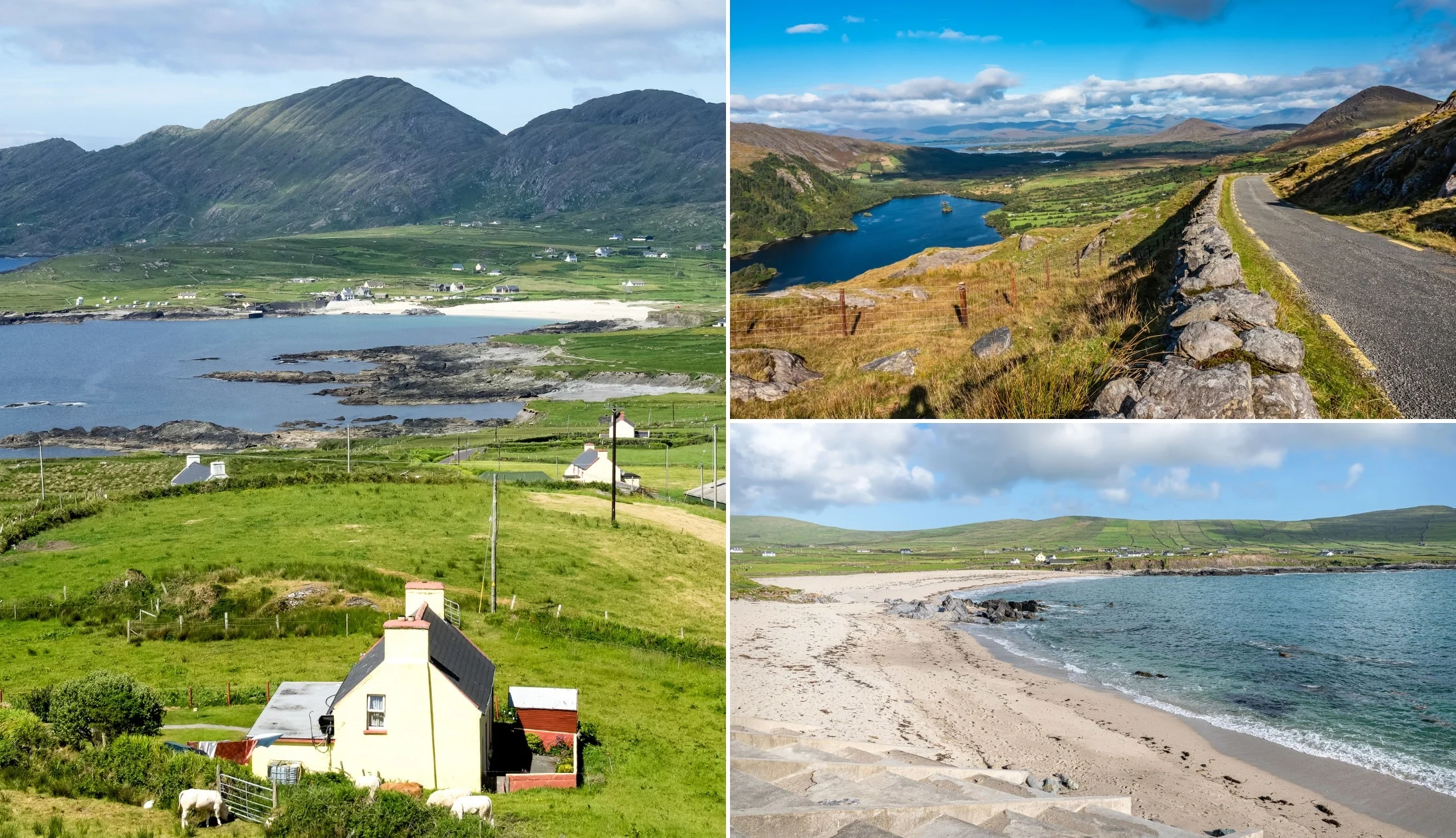
Photos via Shutterstock
You’re more than halfway through your adventure-filled 9 days in Ireland, and today, you’re checking out of your accommodation in Bantry and heading over to the charming town of Kenmare, where you’ll be spending 3 nights.
En route to Kenmare, you’ll be exploring the rugged and wild Beara Peninsula.
Fuel up for the day with a big breakfast at your accommodation or, if you’d rather eat breakfast in town, De Barra’s does a cracking full Irish.
Recommended accommodation in Kenmare
Here are a handful of places that we’d recommend staying in Kenmare:
- Budget: An Bruachan B&B (superb reviews less than a 20-minute walk from town) and Hawthorn House (great reviews and super central)
- Mid-range: O’Donnabhain’s and Bridge Street Townhouse (both very central with exceptional reviews)
- Luxury: Park Hotel (fabulous 5-star in the town) and Lansdowne Kenmare (boutique hotel on the main street)
Stop 1: Glengarriff

Photos via Shutterstock
Drive the 20 minutes from Bantry to Glengarriff, a quaint little village tucked between the ocean and the mountains. We suggest parking in the centre of Glengarriff next to Quills (here on Google Maps), then walking the short distance to the magical Blue Pool.
The Blue Pool is a natural harbour close to the centre of the village. It’s hidden away amongst lush green vegetation, which adds to the enchanting feel of the place.
It’s a popular and tranquil spot with steps leading down to the water. However, the water is very deep and there’s no lifeguard.
Stop 2: The Healy Pass

Photos via Shutterstock
From Glengarriff, drive 18 minutes to Adrigole, where you can take the Healy Pass – arguably one of the most unique roads in Ireland.
This is a scenic drive that winds through the rural landscape, climbing to an elevation of 334 metres.
When you reach the top you can pull in, park and see the entire route from above.
Stop 3: The coastal drive to Allihies for lunch

Photos via Shutterstock
When you finish up at the Healy Pass, you need to double up on yourself a bit, as we’re going to follow the Ring of Beara route along the coast.
Now, anyone that’s spent time on Beara will tell you that this corner of Ireland’s X Factor is the scenery and almost oil-painting-like landscapes that you seem to encounter around every bend.
The drive from the Healy Pass to Allihies will take 50 minutes without stops, so factor in at least 1.5 hours. When you arrive in the town park up and head for a stroll on the beach.
If you’re peckish, we recommend getting lunch at O’Neils Bar and Restaurant, where you’ll find typical bar food on the first floor.
Stop 4: Glenbeg Lough
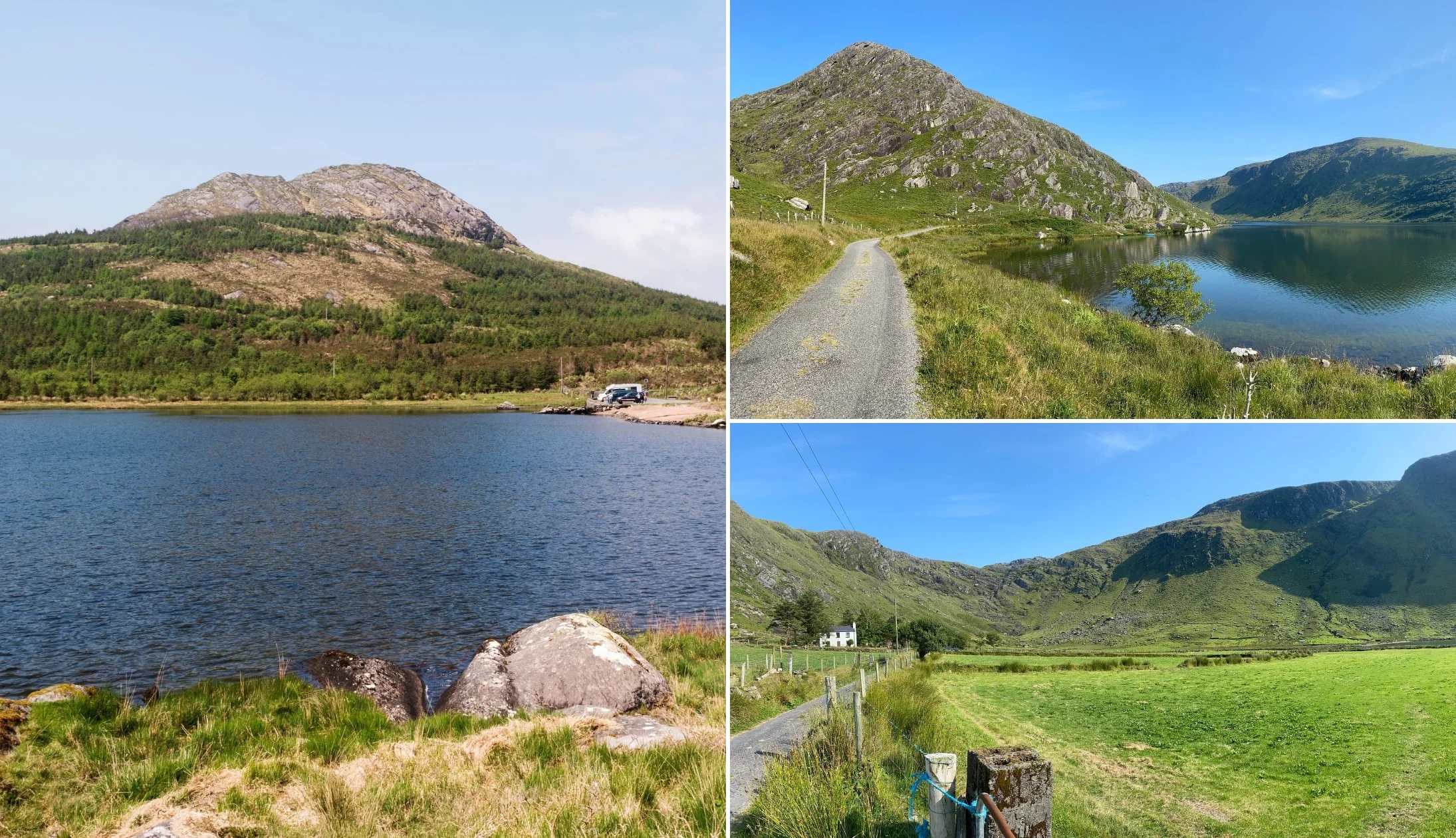
Photos via Shutterstock
After lunch, jump back in the car and drive 40 minutes to Glenbeg Lough, a serene lake hidden away amongst towering mountains.
There’s a small car park and viewing point here, so you can just rock up and take in the amazing views.
Stop 5: Explore Kenmare
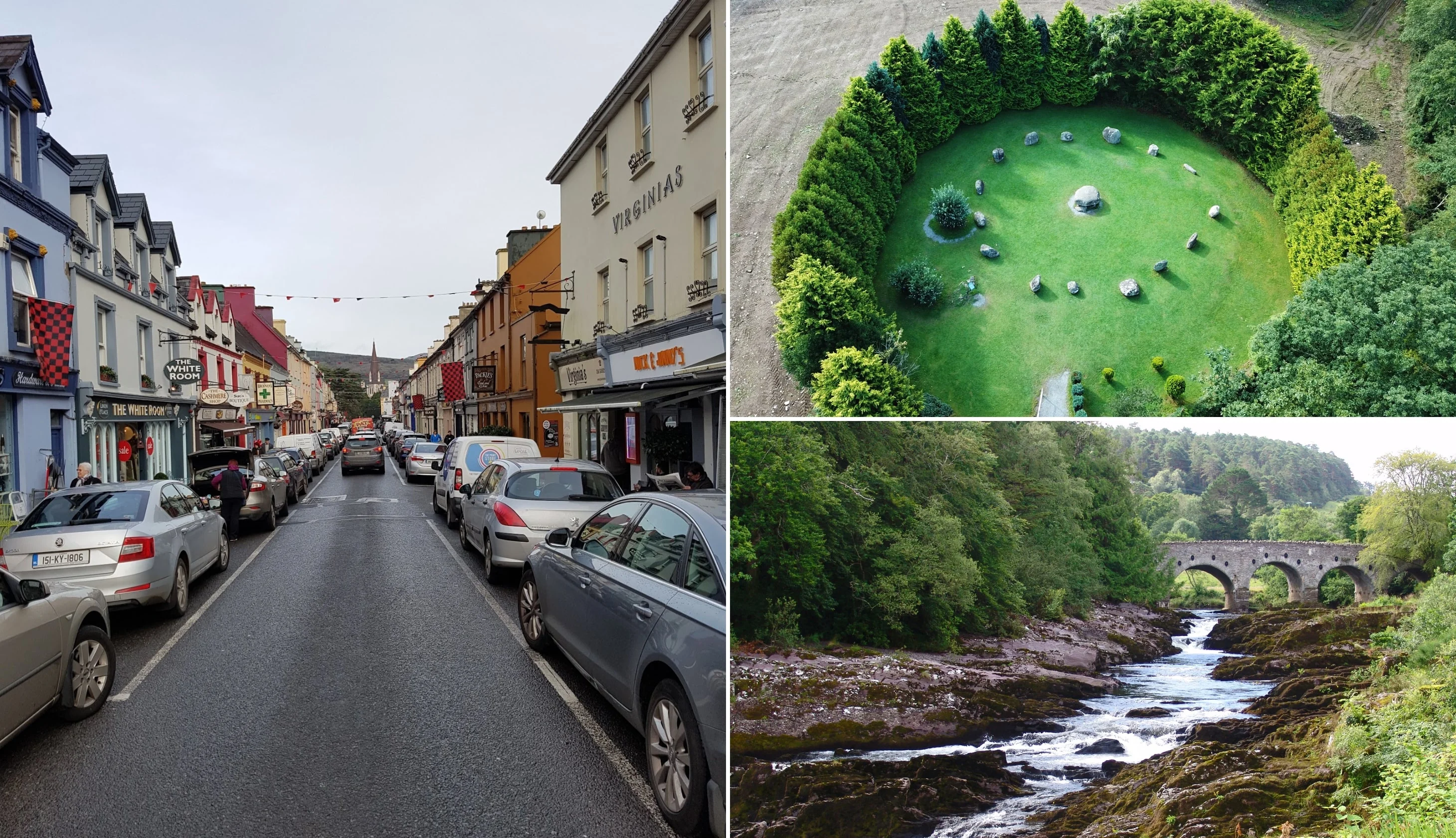
Photo left: The Irish Road Trip. Others: Shutterstock
There’s plenty of things to do in Kenmare. However, we’re going to recommend a mix of history and strolls.
Get checked into your accommodation if you can and then head up to Kenmare Stone Circle. Here you’ll discover 15 heavy boulders in an ellipse-shaped circle that’s thought to date back to the Bronze Age (2,200 to 500 BC)
Then, head across town and enter Reenagross Woodland Park. This is a beautiful park with gorgeous mountain views and forest trails where you can work up an appetite.
Stop 6: Dinner, drinks and live music

Photos via Crowley’s Bar on FB
If you’re visiting Kenmare for the first time, you’re in for a treat. There’s a handful of exceptional restaurants in Kenmare and there’s heaps of great pubs in Kenmare, too!
Our Kenmare food recommendations
For dinner, we recommend No. 35, The Lime Tree, and Mulcahy’s.
No. 35 is a family-run Irish restaurant with a 3-course set menu during dinner. The menu features dishes such as handmade sausage as a starter, free-range pork belly with Carraway cabbage and apple for the main course, and mouth-watering chocolate pudding.
The Lime Tree, which is run out of a historic building that dates back to 1832, is another place to go if you’re craving Irish food. As is Mulcahy’s, although it has more of a tapas vibe with small and large plates.
Our Kenmare pub recommendations
For after-dinner drinks head to PF McCarthys, Crowley’s Bar, or Roughty Bar.
Stick around Crowley’s Bar for music or check out The Coachmans Townhouse.
Day 7: The Ring of Kerry
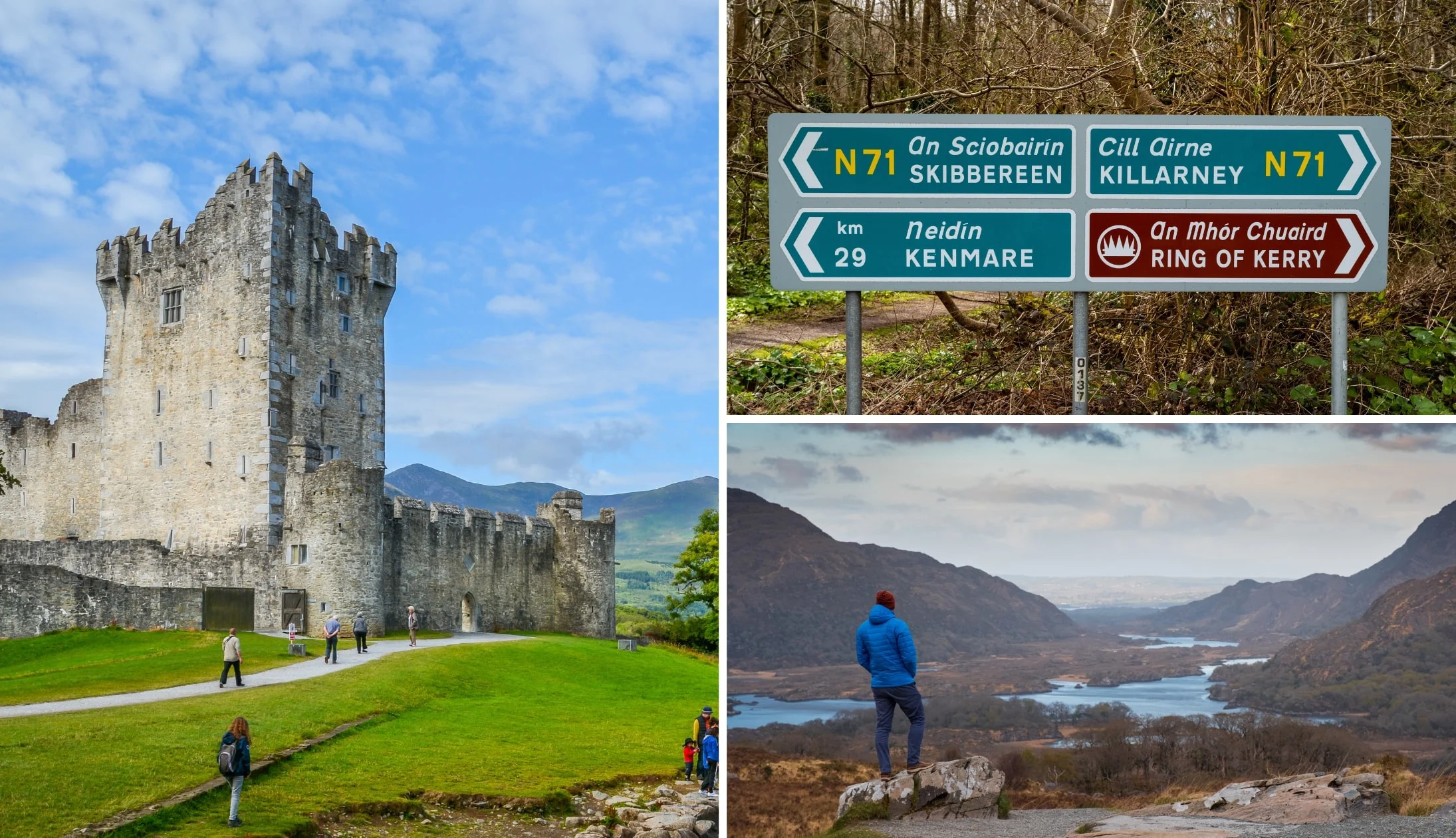
Photos via Shutterstock
Today we are setting off on the Ring of Kerry. You are going to be exploring the ring of Kerry clockwise, stopping at some of our favourite locations that most tour buses just skip by.
Be prepared for breathtaking views, stunning landscapes and the type of scenery that imprints itself upon your mind forever.
We’d strongly recommend reading this Ring of Kerry guide (with a handy Google Map) before you set off as it’ll tell you everything you need to know.
Start the day by grabbing breakfast at your accommodation, or if you feel like eating breakfast out, we normally hit up Poffs or Cafe de Mocha.
Stop 1: Derrynane Beach
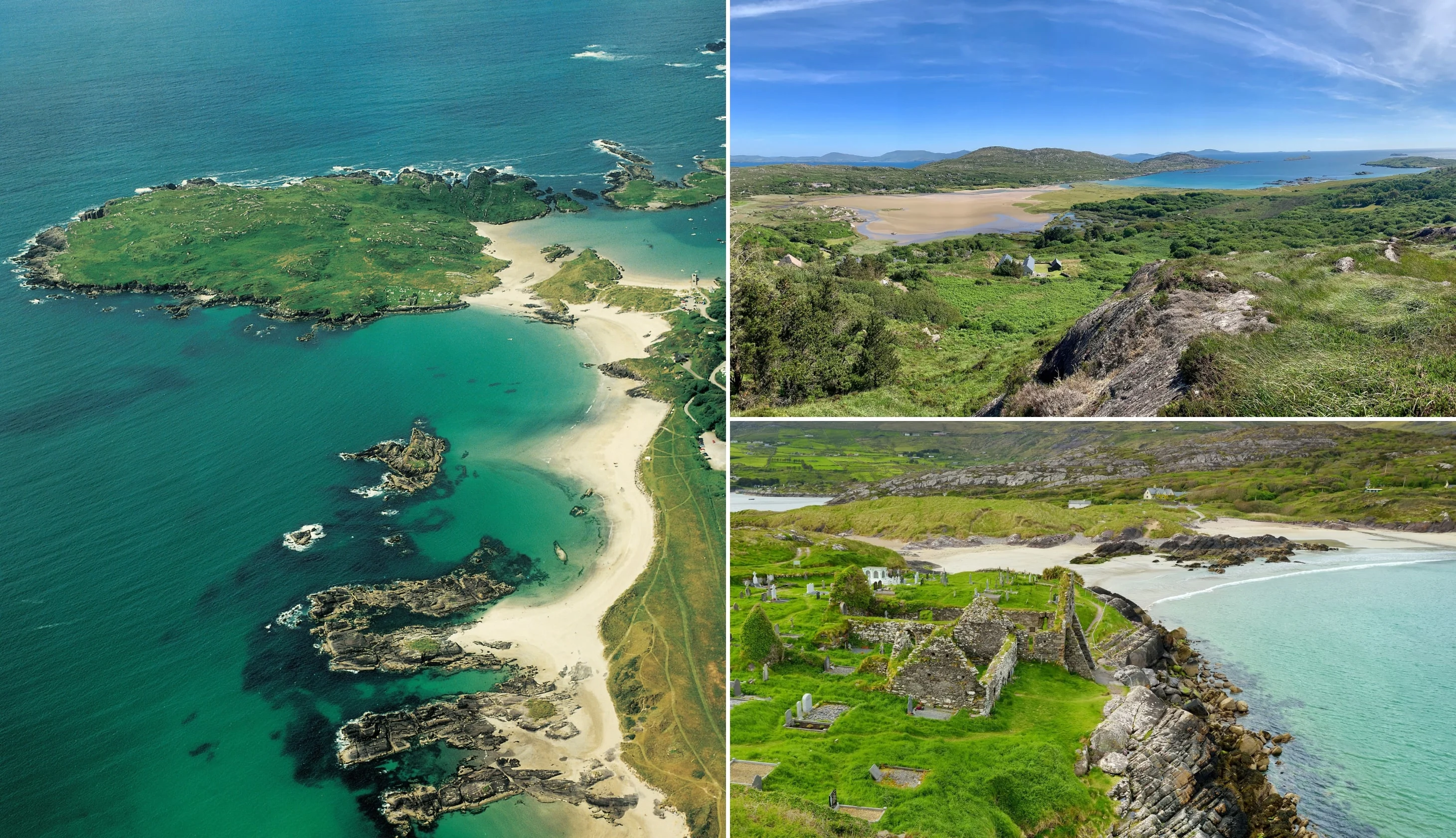
Photos via Shutterstock
Enjoy the incredibly scenic hour drive from Kenmare to Derrynane Beach, a lovely white-sand beach backed by soft sand dunes.
There are wonderful views on all sides, with a nature reserve at the back, Derrynane Abbey to the right, and rocky outcrops to the left.
Although the water might look inviting, there are dangerous currents, and a small section is known locally as “Danger Beach”.
Stop 2: Waterville

Photos via Shutterstock
Drive 20 minutes to reach Waterville, a seaside resort town known as Charlie Chaplin’s favourite village in Ireland!
It’s a great place for a wander, just don’t forget to pass by the Charlie Chaplin statue in front of Waterville Beach.
Stop 3: Ballinskelligs
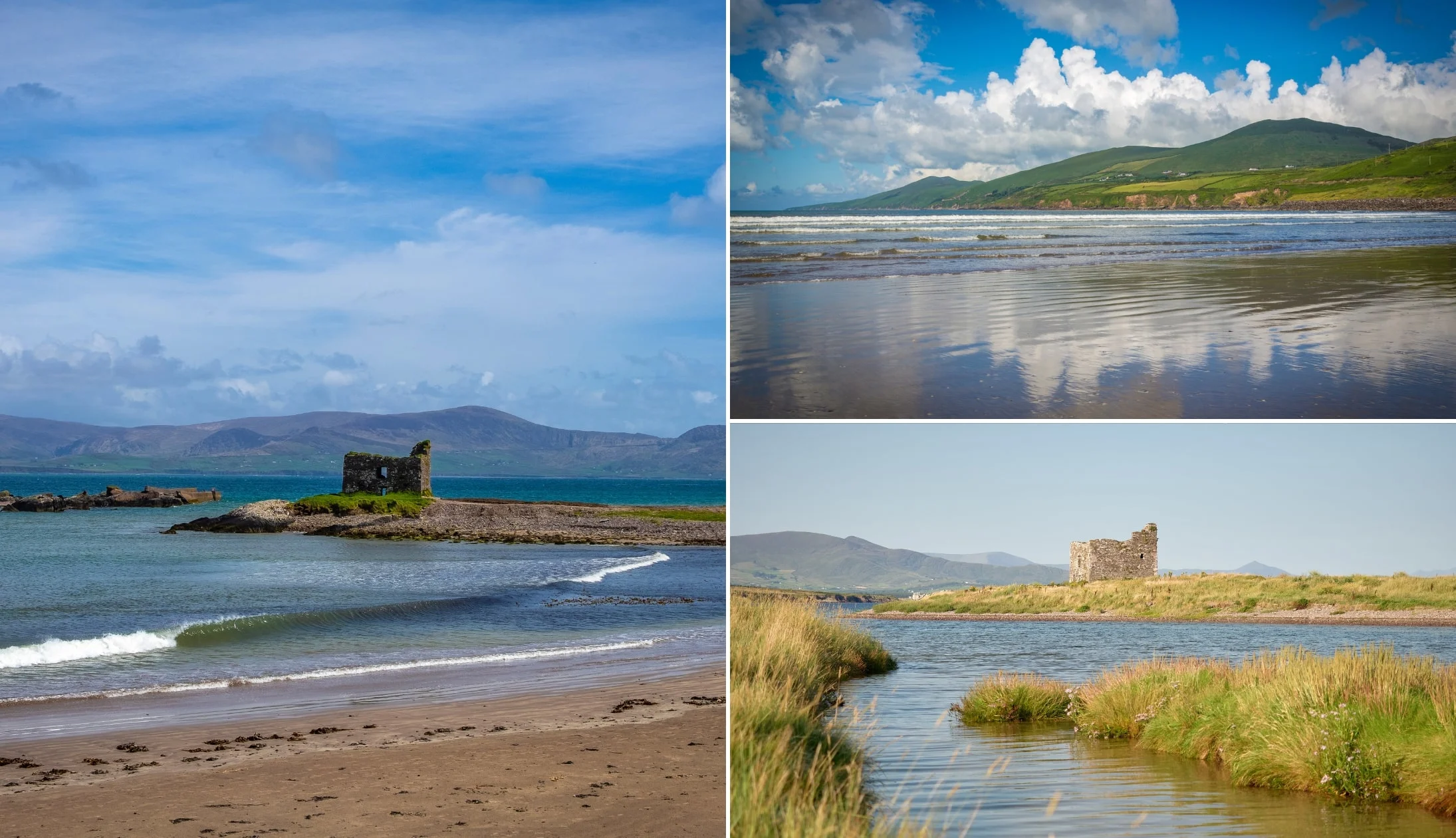
Photos via Shutterstock
Ballinskelligs is a 15-minute drive from Waterville, and this section of the route takes you onto what’s known as the Skellig Ring.
The village’s history dates all the way back to the 5th or 6th century, to the monks who lived on the almost uninhabitable Skellig Michael nearby.
There’s lots to do in the area, from visiting the beautiful sandy beaches and checking out the Ballinskelligs Abbey ruins to exploring the Ballingskelligs Castle ruins a short walk away along the shore.
Stop 4: Coomanaspig Pass

Photos via Shutterstock
The Coomanaspig Pass is one of the highest points in Ireland that can be accessed by car. From the top, the views are spectacular, and the drive up to the pass is equally as stunning.
Approach the pass via the R565 and Skellig Ring. The drive takes just under 30 minutes, with plenty of places to pull over and take in the view.
Stop 5: The Kerry Cliffs

Photos via Shutterstock
Continue onto the Kerry Cliffs less than 5 minutes down the road. The cliffs are absolutely magnificent, rising 300 metres above the Atlantic Ocean.
The views from the Kerry Cliffs are wonderful, and on clear days you can see The Skelligs to the west as well as Puffin Island!
Admission to the cliffs cost €4 and there are plenty of places to park. The cliffs are open daily from 9am to 7:30pm.
Stop 6: Lunch in Portmagee
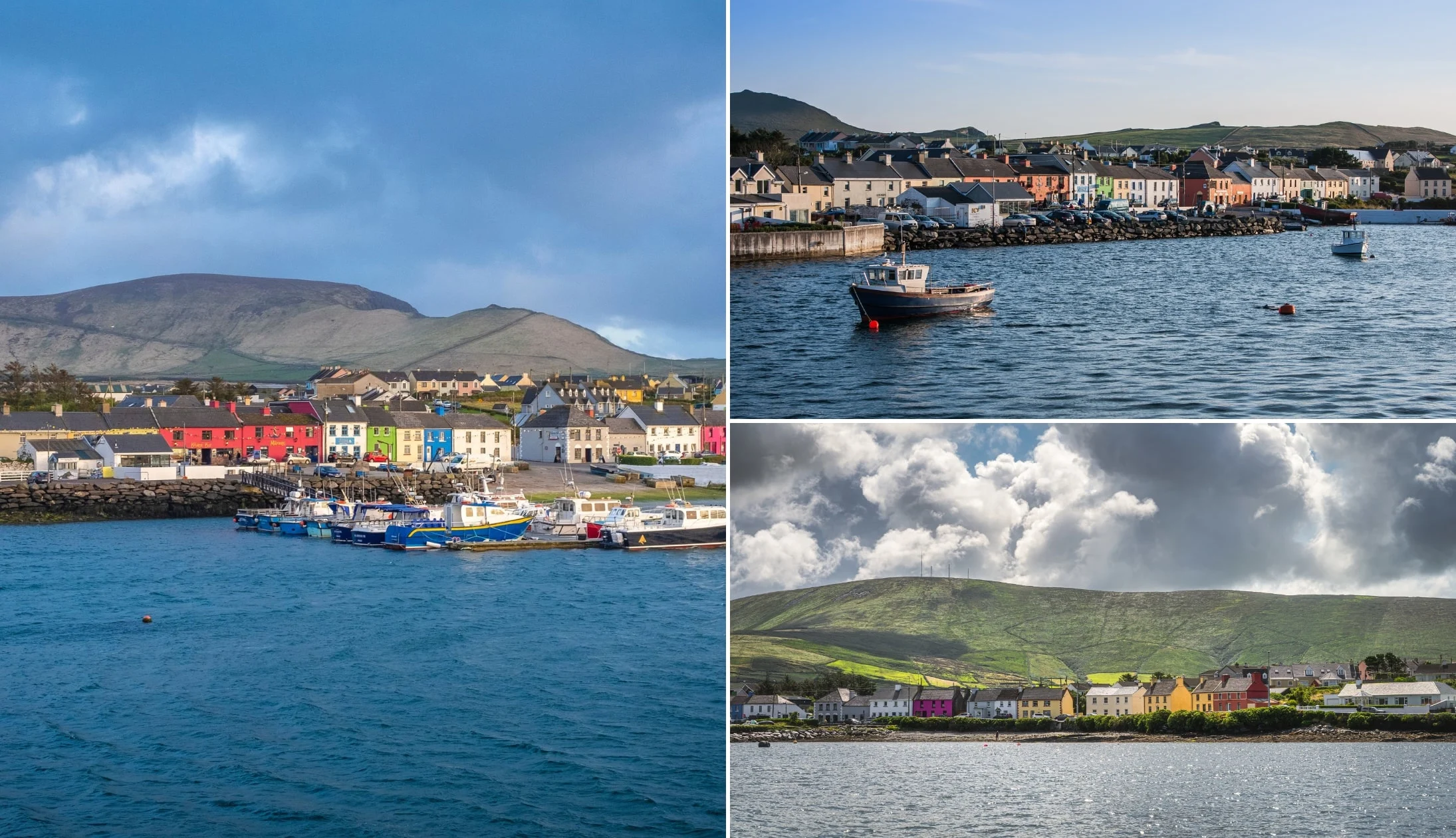
Photos via Shutterstock
It’s time for lunch, and we suggest heading to the Smuggler’s Cafe or The Fisherman’s Bar in nearby Portmagee.
Both restaurants serve delicious seafood, so take your pick! The village is absolutely tiny and it comes alive during the summer months.
Stop 7: Valentia by way of Portmagee
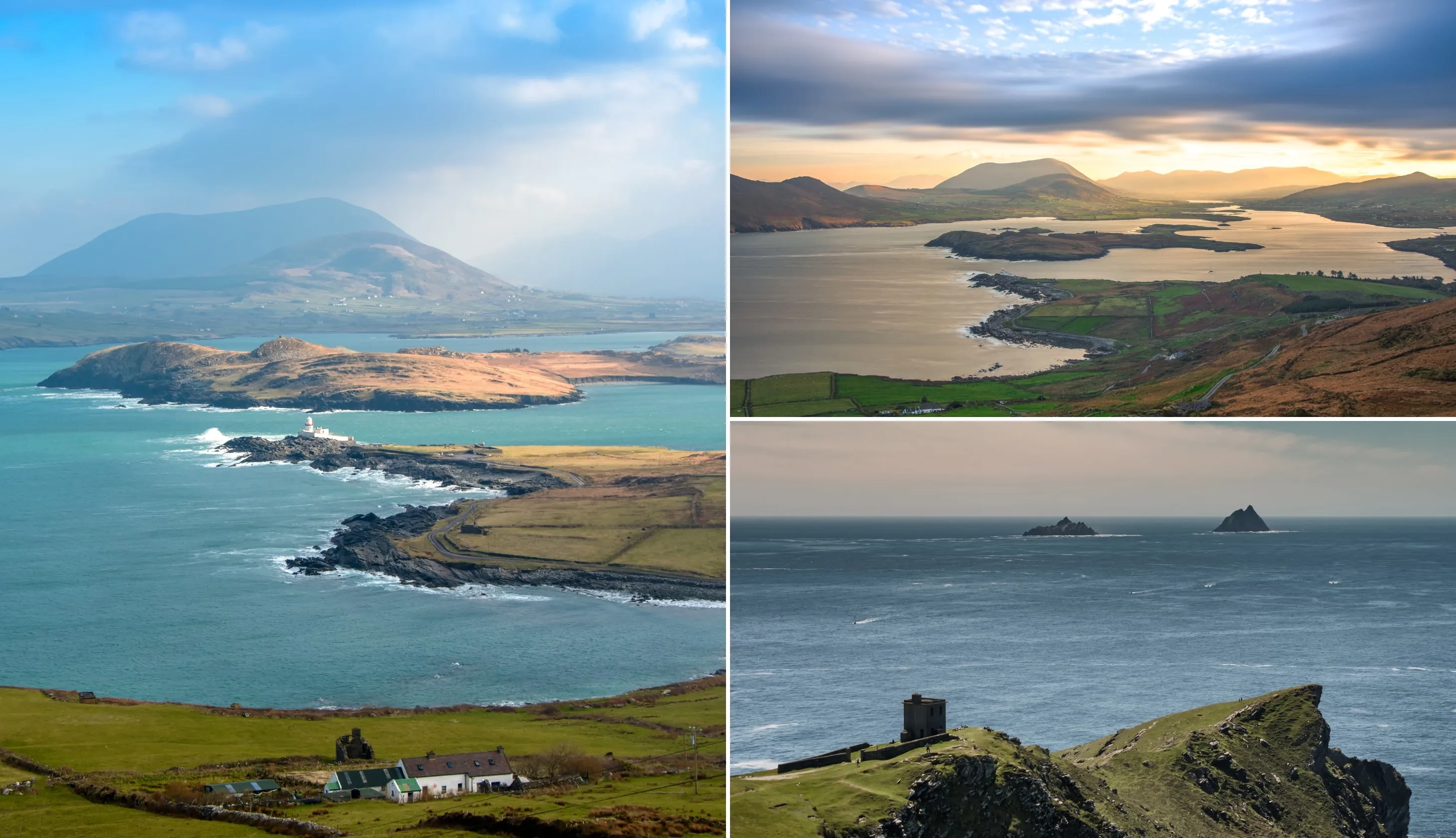
Photos via Shutterstock
It’s time to head to Valentia Island, one of Ireland’s most westerly points. From the Kerry Cliffs, it’s a short drive onto the island via the bridge in Portmagee.
You’ll be using this route to get onto the island, but please note that to get off the island, you’ll be taking the ferry in Knight’s Town (more details below).
There’s lots to do in Valentia, but some of our favourite things are the Valentia Island Lighthouse, the Slate Quarry, and the stunning Geokaun Mountain and Fogher Cliffs.
The Slate Quarry is the most westerly quarry in Europe and the oldest quarry in production in Ireland. Slate from the quarry can be found in Westminster Abbey, the Paris Opera House, and the Houses of Parliament.
Geokaun Mountain is the highest point on the island, standing 270 metres tall. The Fogher Cliffs are on the northern face of Geokaun, with incredible views of the Atlantic, distant mountains, and several islands.
There are three car parks/viewing points along the way. The last one here is the closest to the summit. The landowner charges a small entry fee.
Once you’re finished exploring Valentia, it’s time to take the ferry from Knight’s Town off the island. The ferry runs between 7:45am and 9:25pm Monday – Saturday and 9am to 9:25pm on Sunday. Check the latest timetable on their Facebook Page.
Stop 8: Cahersiveen

Photos via Shutterstock
From the pier in Reenard Point, it’s a 7-minute drive to Cahersiveen. Some cool places to check out in the area are the Old Barracks, which has several exhibitions about the history of the local area, including The Life and Times of Daniel O’Connell, and the Cahersiveen ring forts, which are roughly 3km from town.
Park here to explore the Leacanabuaile Ring Fort and the Cahergall Stone Fort on foot.
Stop 9: Rossbeigh
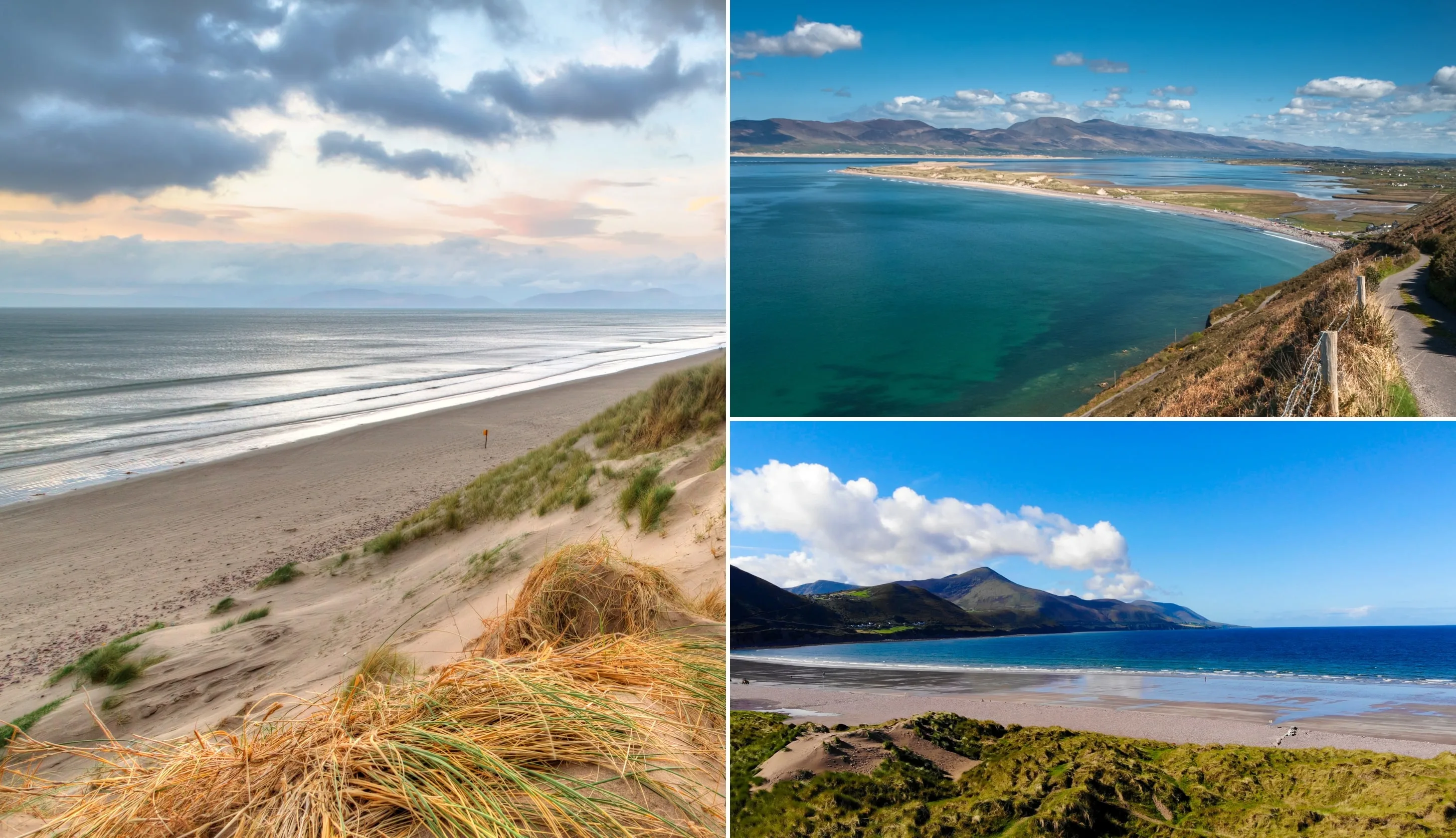
Photos via Shutterstock
From Cahersiveen, Rossbeigh Beach is a 30-minute drive. Rossbeigh Beach is a beautiful 6km long sandy beach with great views over Dingle Bay.
It’s a Blue Flag beach and one of the most popular in the area! We love it for a summer swim or a nice scenic walk in the winter.
Stop 10: Killarney Town

Photos via Shutterstock
You’re a good 45-minute drive from the next stop of the day, Killarney Town – arguably the busiest spot along the route.
If you feel like stretching your legs a bit, consider grabbing a coffee to go from Bean in Killarney and then going for a little wander through this lovely town.
Stop 11: Ross Castle
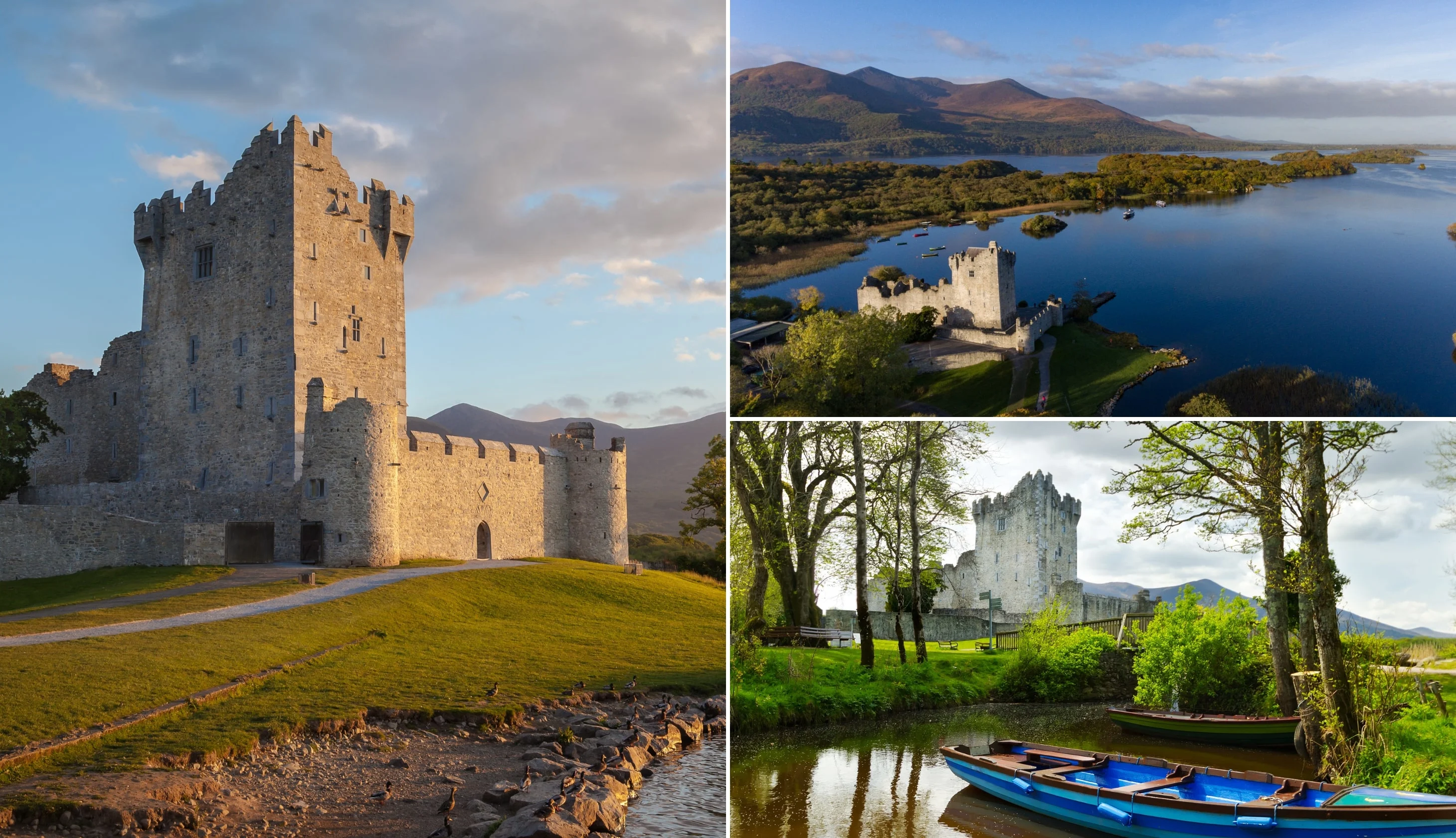
Photos via Shutterstock
From Killarney, it’s a 7-minute drive to Ross Castle in the glorious Killarney National Park. The castle was built by O’Donoghue Mór, an Irish Chieftain in the 15th century.
The castle is in great condition and sits on the shores of Lough Lenane. It’s steeped in mystery, and according to local legend, O’Donoghue still sleeps under the lake’s waters, rising every seven years on the first morning of May.
You can either visit the grounds and admire the castle from the outside or buy a ticket and join a guided tour. During the tour, you’ll be taken through the various rooms and given information about the castle’s past inhabitants. The tour lasts around 45 minutes.
Stop 12: Torc Waterfall
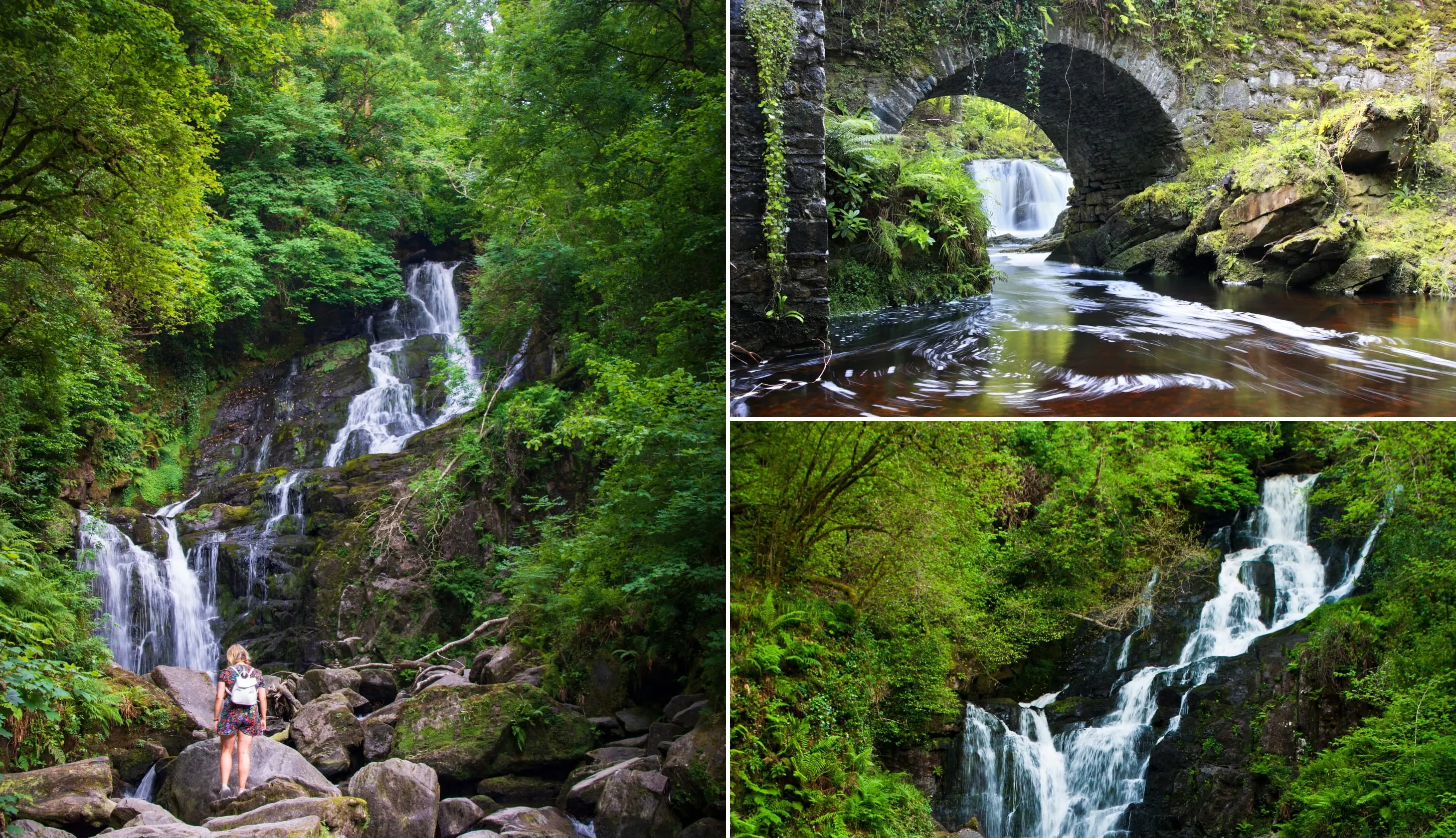
Photos via Shutterstock
From Ross Castle, drive 15 minutes to the enchanting Torc Waterfall. According to local folklore, the waterfall was home to a man who was cursed by the devil to turn into a boar each night.
When his secret was revealed by a farmer, the man burst into flames and retreated to the Devil’s Punchbowl.
There are two car parks close by, but in our experience, the closest car park, Killarney Hiking Parking Lot (here) is often full. So, you may need to park in the Torc Waterfall Lower Parking on the N71 (here).
From the Torc Waterfall Lower Parking, it’s roughly 1km to the waterfall along a paved cycle path that passes by some gorgeous scenery.
From Killarney Hiking Parking Lot, there’s a small path that cuts through the forest and joins up with the cycle path roughly 250 metres from the waterfall.
Stop 13: Ladies View
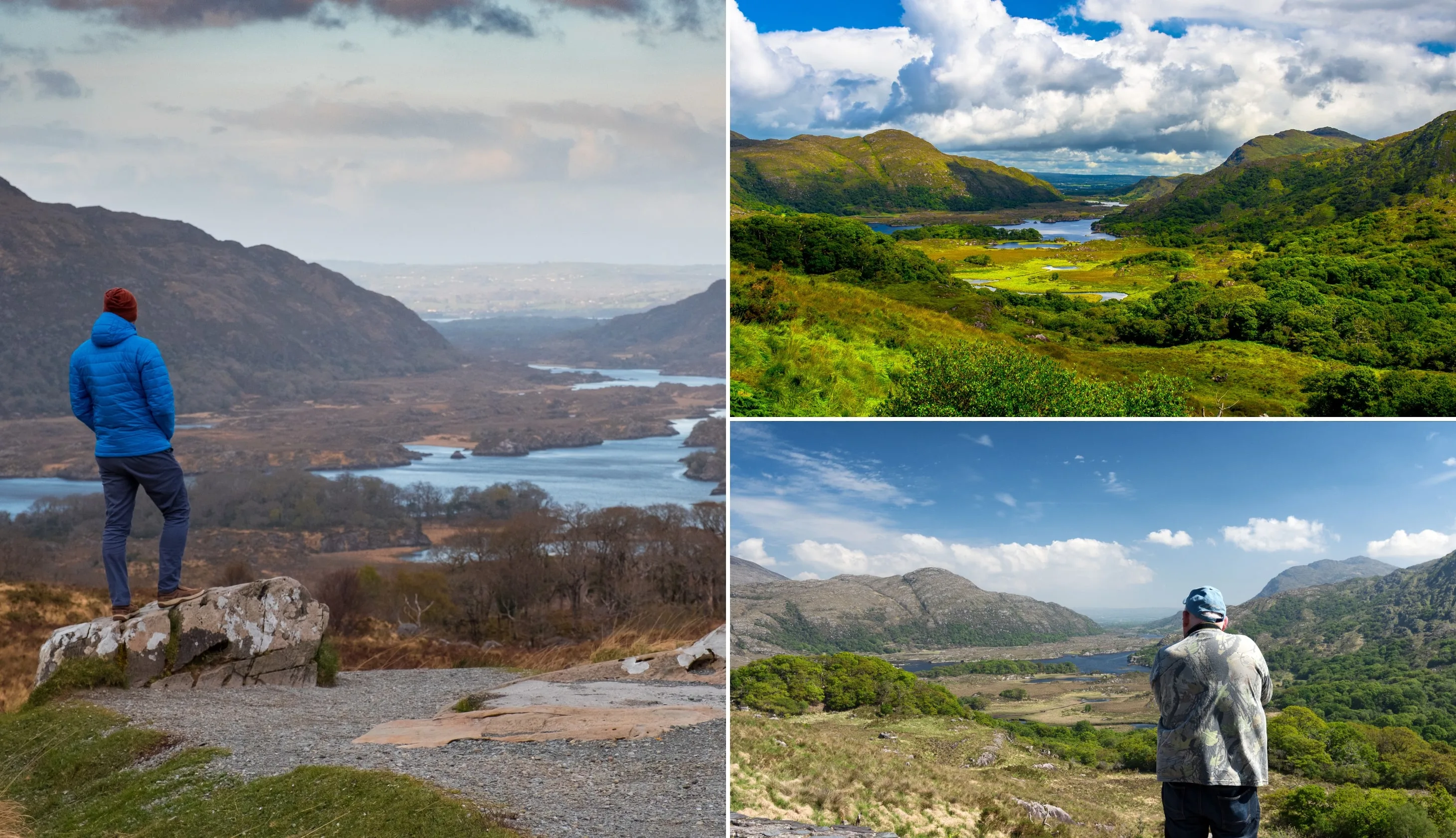
Photos via Shutterstock
From Torc Waterfall, it’s roughly a 15-minute drive to Ladies View. The viewpoint here is a popular stopping point on the Ring of Kerry road, with roadside parking directly facing the view (see parking here on Google Maps).
The viewpoint was named in honour of Queen Victoria’s ladies-in-waiting who were in awe when they visited in 1861 during a royal visit. The view looks out over the Upper Lake with mountains rising up on either side.
Stop 14: Moll’s Gap

Photos via Shutterstock
Drive for around 9 minutes along the N71 to another popular spot on the Ring of Kerry road, Moll’s Gap! There’s plenty of parking at Molls Gap, but take care as the parking area is on a sharp bend.
Molls Gap is also known as Céim an Daimh in Irish or ‘Gap of the Ox’, but it gets its nickname after Moll Kissane, owner of a local shebeen (unlicensed pub).
The pub was established in the 1820s when the road was being built, and Moll’s homemade poitin (a strong liquor sometimes made from potatoes) was a favourite with the construction workers!
Stop 15: Kenmare for the night

Photos via Crowley’s Bar on FB
Continue on the N71 for 12 minutes to get back to Kenmare. If you need to call by your accommodation to freshen up before dinner.
Our Kenmare food recommendations
For dinner, we recommend No. 35, The Lime Tree, and Mulcahy’s.
No. 35 is a family-run Irish restaurant with a 3-course set menu during dinner. The menu features dishes such as handmade sausage as a starter, free-range pork belly with Carraway cabbage and apple for the main course, and mouth-watering chocolate pudding.
The Lime Tree, which is run out of a historic building that dates back to 1832, is another place to go if you’re craving Irish food. As is Mulcahy’s, although it has more of a tapas vibe with small and large plates.
Our Kenmare pub recommendations
For after-dinner drinks head to PF McCarthys, Crowley’s Bar, or Roughty Bar.
Stick around Crowley’s Bar for music or check out The Coachmans Townhouse.
Day 8: Dingle Peninsula
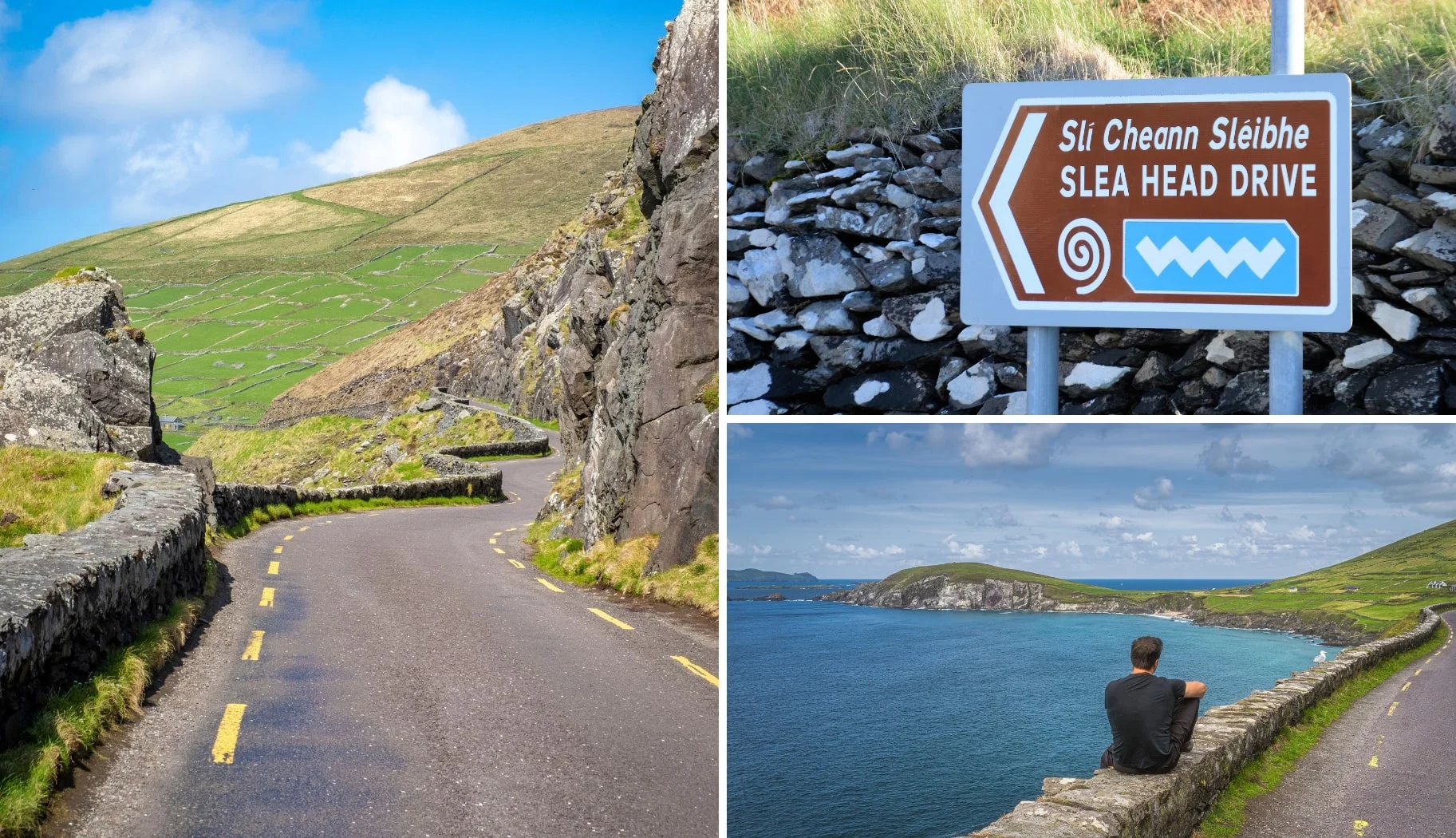
Photos via Shutterstock
Today, you’ll be exploring the Dingle Peninsula. A beautifully remote corner on the country’s southwest coast, with rugged coastline, lovely beaches, and rolling green hills.
Start the day with a big breakfast at your accommodation before you check out, or look back on our breakfast suggestions from previous days!
A note about today
We’re going to give you all of the main attractions located along what’s often referred to as the Dingle Peninsula Loop – you don’t have to visit all of them.
But we want to give you a sense of the stops, some of which get missed, so you can decide which you’d like to see and which you’d like to avoid.
In this guide you’ll find a map with the looped drive outlined along with all the key stops.
Stop 1: Inch Beach

Photos via Shutterstock
Our first stop of the day is a 1.5 hour spin from Kenmare.
Inch Beach, as you’ll see from the photo on the left above, is nearly like a little peninsula in itself. It stretches for an impressive 5.5km and it’s a lovely spot for a stroll.
There’s a small car park up front and, before you braze the chill Atlantic breeze, you can grab a coffee from Sammy’s (you can’t miss it).
As you ramble, you’ll see surfers attempting to conquer the waves whole the mountains of Kerry off in the distance seem to loom over you from every angle.
Stop 2: Minard Castle and beach
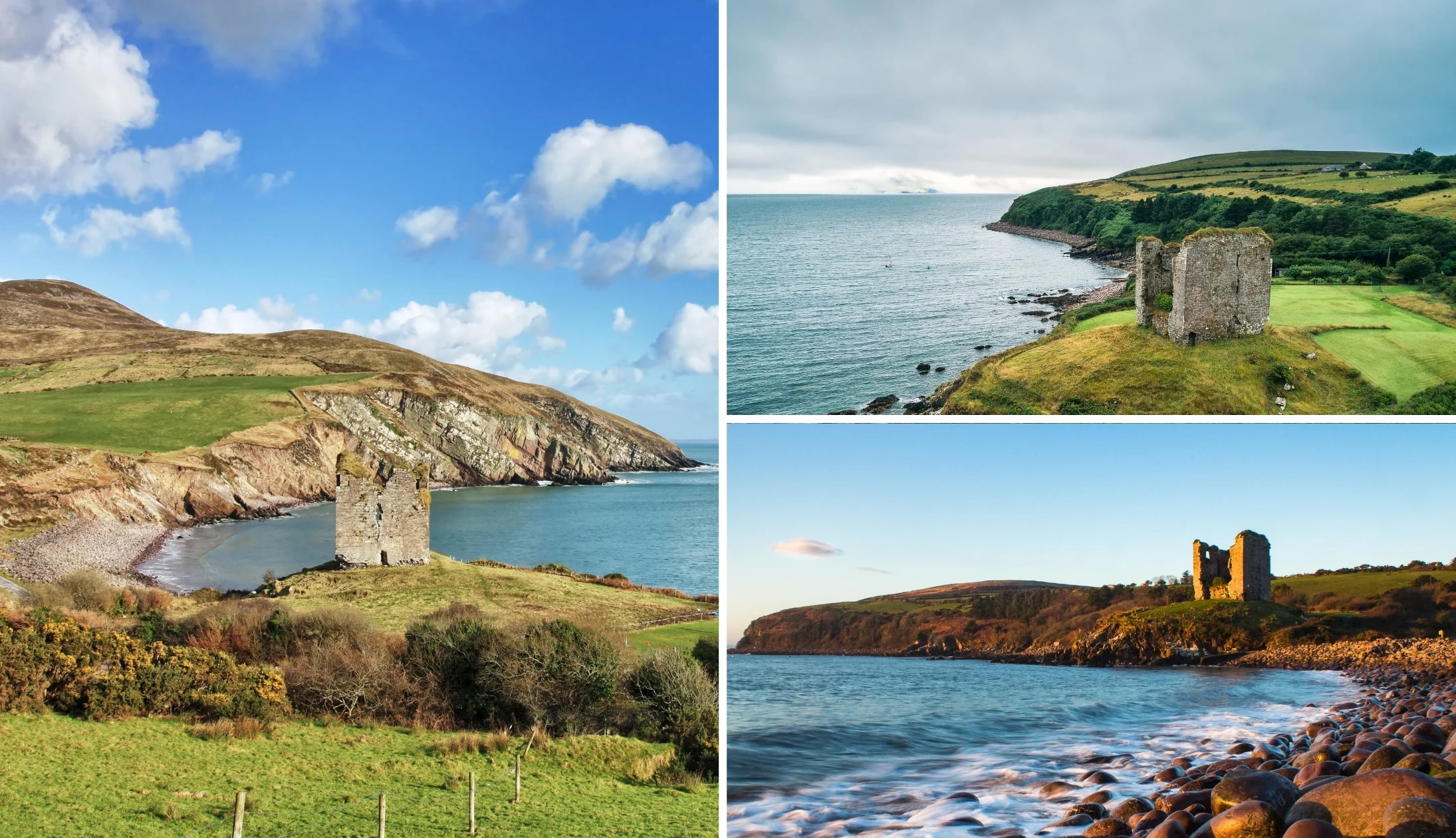
Photos via Shutterstock
Now, if you’ve ever watched the 1970’s film ‘Ryan’s Daughter’, you might recognise Minard Castle, which was referred to in the movie as ‘The Tower’. It’s a 15-minute drive from Inch Beach.
The castle here is finely plonked on a little grassy hill that overlooks the water, commanding breathtaking views on a clear day.
Minard Castle dates to the 16th century and it is one of several ‘Fitzgerald castles’ that were built by the Knight of Kerry on the Dingle Peninsula.
Stop 3: Conor Pass

Photos via Shutterstock
Next up is Conor Pass – a 25-minute drive from Minard Castle. At an impressive 410m above sea level, the mighty Conor Pass is one of Ireland’s highest mountain passes, and it can be the stuff of nightmares for nervous drivers.
However, you don’t have to drive it. If you head up to it from the Dingle side, you’ll reach a car park before you hit the narrow road.
From here, you can soak up views of the surrounding valley and watch the cars navigate its narrow bends from afar.
Stop 4: Dingle Town
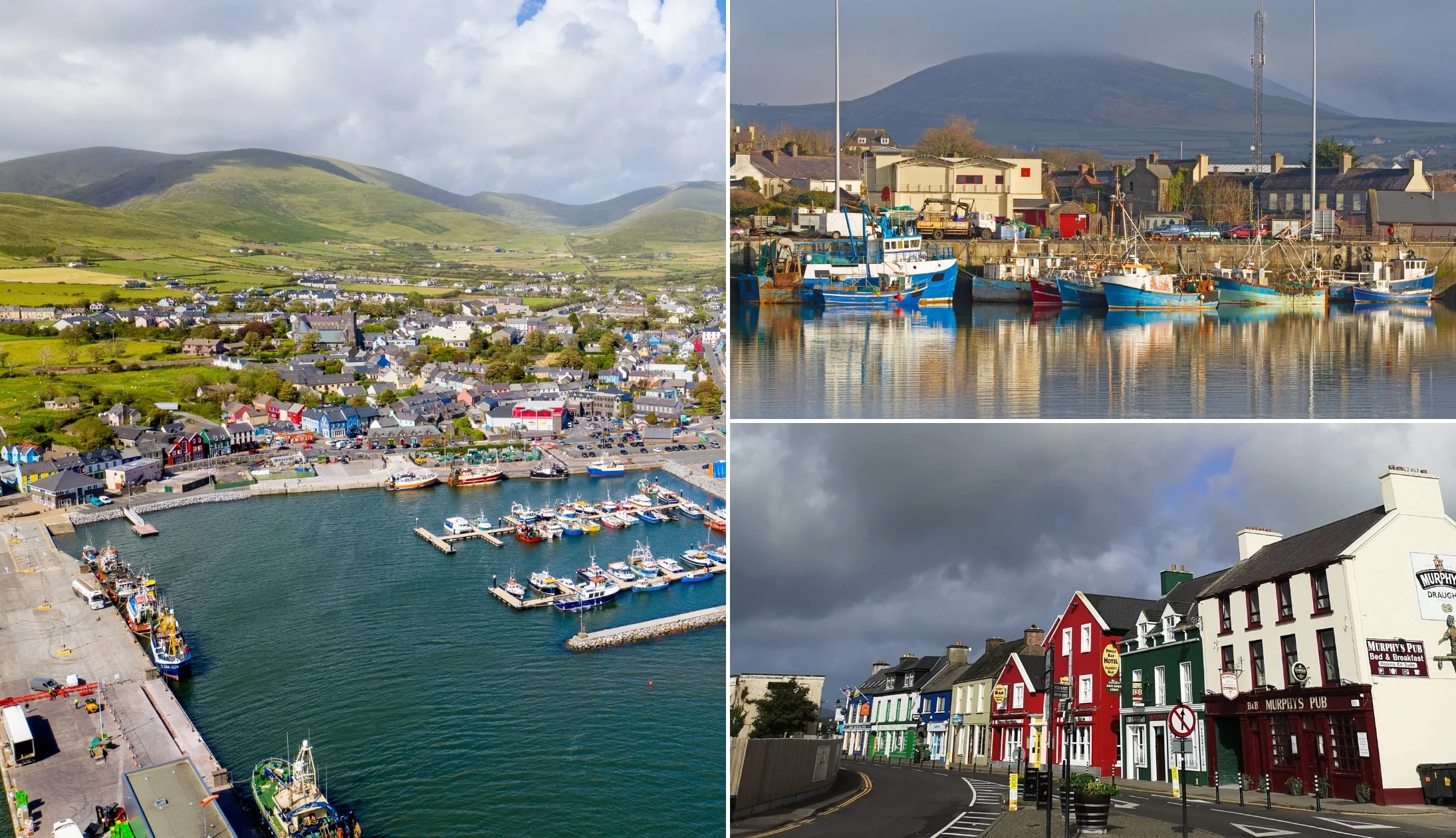
Photos via Shutterstock
You’ll have to double back on yourself next, and drive the short 10 minutes to the lively Dingle Town.
It’s well worth parking up (you’ll find a car park at the pier), hopping out and heading for a stroll around this colourful little town.
It’s very walkable and, while very touristy, it boasts a fine bit of charm and character. In the town, you have attractions like the Dingle Distillery and the Dingle Aquarium.
There’s also plenty of great restaurants in Dingle (Fish Box is our go-to!) and there are endless old-school pubs in Dingle, too!
From the town, you can join one of the various Dingle Tours, like the Sea Safari or the boat trip to the Blasket Islands.
Stop 5: Ventry Beach

Photos via Shutterstock
Ventry Beach (12-minute drive from Dingle) is a Blue Flag Beach and it has a lifeguard service throughout the summer months. On a warm day, there’s few places like it.
One of the more popular beaches in Kerry, Ventry Beach stretches for around 4.5km, and, for me, it marks the beginning of the Slea Head Drive.
Hop out, flick off your shoes and head for a stroll or a paddle. It’s from this point that the Dingle Peninsula Drive goes from good to great!
Stop 6: Beehive huts, forts and sheepdog demonstrations

Photos via Shutterstock
So, these next stops are completely optional. After you leave Ventry, you’ll follow the road to the coast and it’s here that there are several paid and free attractions.
The first you come to is the Celtic Prehistoric Museum, the second is the FairyFort Ringfort, the third are the Dingle Sheepdog Demonstrations, the Famine Cottages and Dunbeg Fort and the fifth is the Beehive Huts.
You’ll then drive around a bend and reach Cashel Murphy followed by a place where you can hold a baby lamb
Personally, I’ve never done them, and I likely never will, but I know of many visitors to the Dingle Peninsula that have.
Stop 7: The viewpoints

Photos via Shutterstock
Now, a word of warning – the Dingle Peninsula Drive has numerous viewpoints. Unfortunately, many of them are beyond bends in the road and you often find yourself missing them.
The issue then is that, at certain stages of the route, there’s very few places to turn. The first two you arrive to are Ceann Sleibhe and the White Cross.
Both are next to each other and each is worth stopping at if there’s room to do so.
Stop 8: Radharc na mBlascaoidí viewpoint

Photos via Shutterstock
The next viewpoint, listed as Radharc na mBlascaoidí or Blasket’s View on Google Maps is one of my favourites on the Dingle Peninsula Drive.
There’s a nice bit of parking here and you’ll be treated to a good eyeful of Dunmore Head. If you’re here when the weather is wild, you’ll see (and hear!) waves bashing against the craggy cliff face below.
Stop 9: Coumeenoole Beach
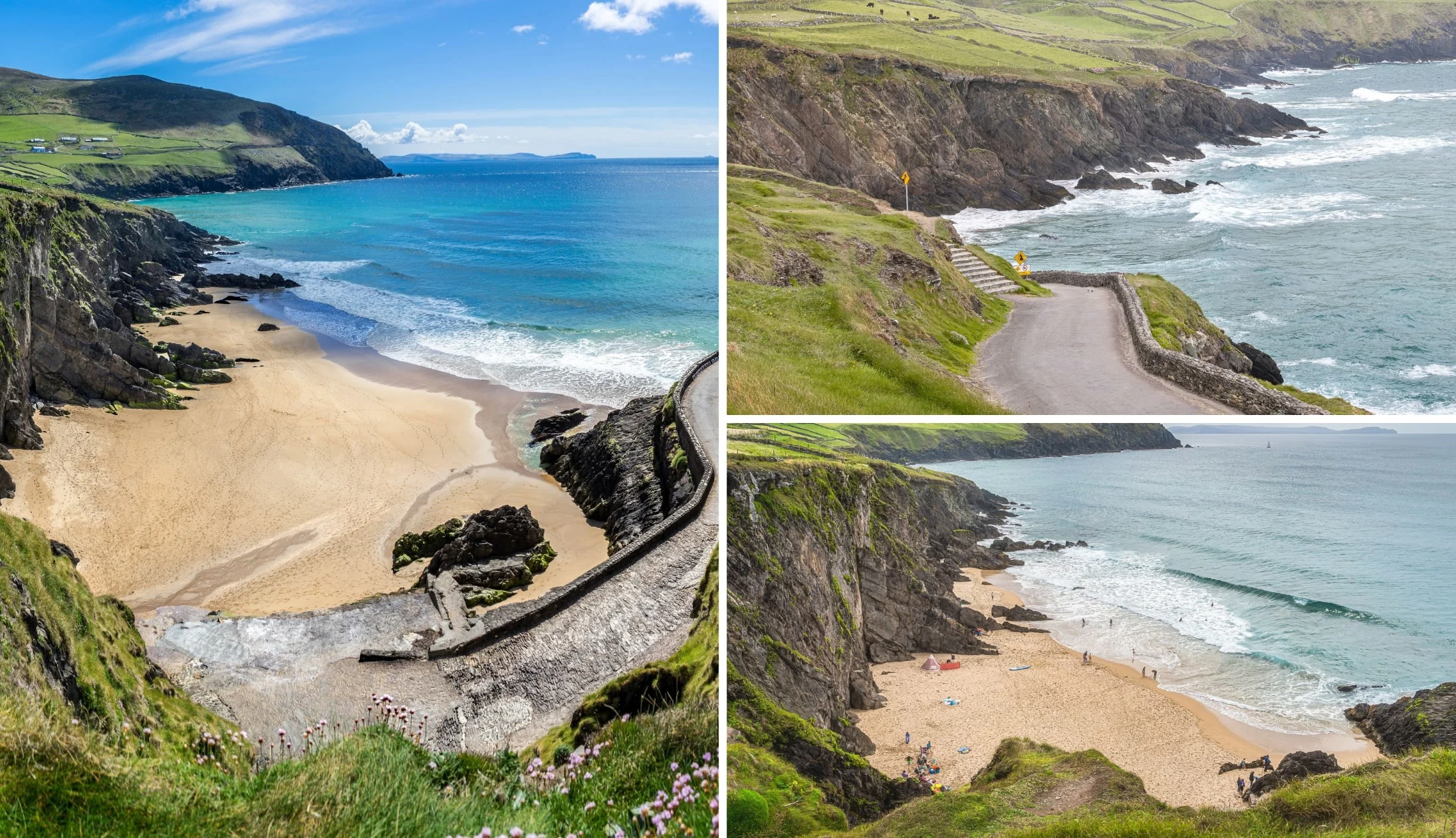
Photos via Shutterstock
Next up is Coumeenoole Beach – another filming location for the movie ‘Ryan’s Daughter’. However, this one comes with a WARNING.
No matter how inviting the water looks here, never enter it – the bay here catches the full force of the Atlantic which creates strong and unpredictable currents.
There’s a little parking area next to the beach and you can either admire it from above or walk down the winding track to the sand.
Stop 10: Dun Chaoin Pier

Photos via Shutterstock
Dun Chaoin Pier is arguably the most notable of the many Dingle Peninsula attractions, thanks to its quirky appearance.
This is the departure point for the ferry to the Blasket Islands and it’s particularly impressive at sunrise and sunset.
Now, another warning – every year a tourist attempts to drive down the path here and gets stuck, destroying their car in the process.
There’s a bit of parking near the ticket office – never… ever attempt to drive down it!
Stop 11: The Blasket Centre

Photos courtesy Valerie O’Sullivan via Ireland’s Content Pool
The Blasket Centre is a good option if you’re doing the Dingle Peninsula Drive when it’s raining and you need a bit of respite.
Boasting magnificent views of the coast and the islands, the Blasket Centre offers an insight into the unique community that lived on the remote Blasket Islands prior to they were evacuated in 1953.
As you walk around it, you’ll get an insight into island life, how the island’s inhabitants made ends meet and plenty more.
Stop 12: Ceann Sraithe (Star Wars filming location)
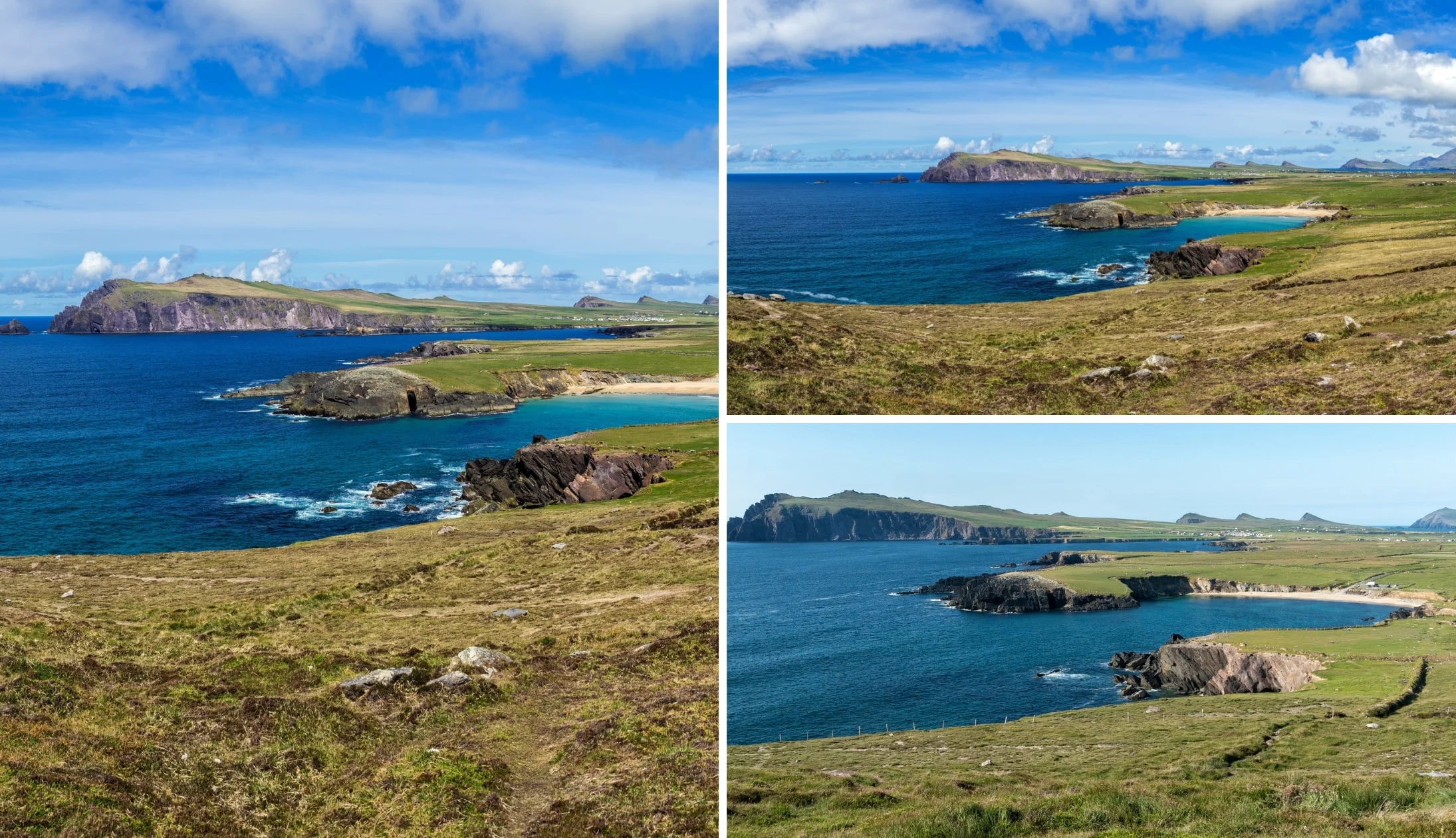
Photos via Shutterstock
As you may be aware, parts of Star Wars: The Force Awakens were filmed in Ireland, most notably on Kerry’s Skellig Michael.
However, a section of the Dingle Peninsula was also used to recreate the Skellig Michael set for later movies. We have this point plotted on the map above.
Now, a warning – there’s no dedicated parking area here, just hard shoulder, so please use caution and never block the road.
Stop 13: Clogher Strand

Photos via Shutterstock
Our next stop is Clogher Strand – one of many little coves that you’ll find dotted around the Dingle Peninsula.
While swimming isn’t allowed here, Clogher Strand is a gorgeous little beach that’s surrounded by rugged cliffs on all sides.
It can make a nice little stop-off point as it’s generally nice and quiet.
Stop 14: Wine Strand

Photos via Shutterstock
One of the more impressive beaches on the Dingle Peninsula is the mighty Wine Strand, a short spin from the previous stop.
There’s a little car park here and, as it’s tucked a little out of sight, tends to get missed by those driving Slea Head.
The views from here are outstanding and you’ll often have the place all to yourself in the off-season,
Stop 15: Gallarus Oratory

Photos via Shutterstock
Gallarus Oratory is one of the final stops on the Dingle Peninsula Drive, and it’s a place that gets plenty of mixed reviews.
There’s a visitor centre (which you need to pay into) or, if you can find parking nearby, you can access it for free via a public path.
It’s believed that Gallarus Oratory was built around the 11th or 12th century. It’s a pokey little structure, standing at just 4.8m by 3m in size.
Stop 16: Dingle for Dinner
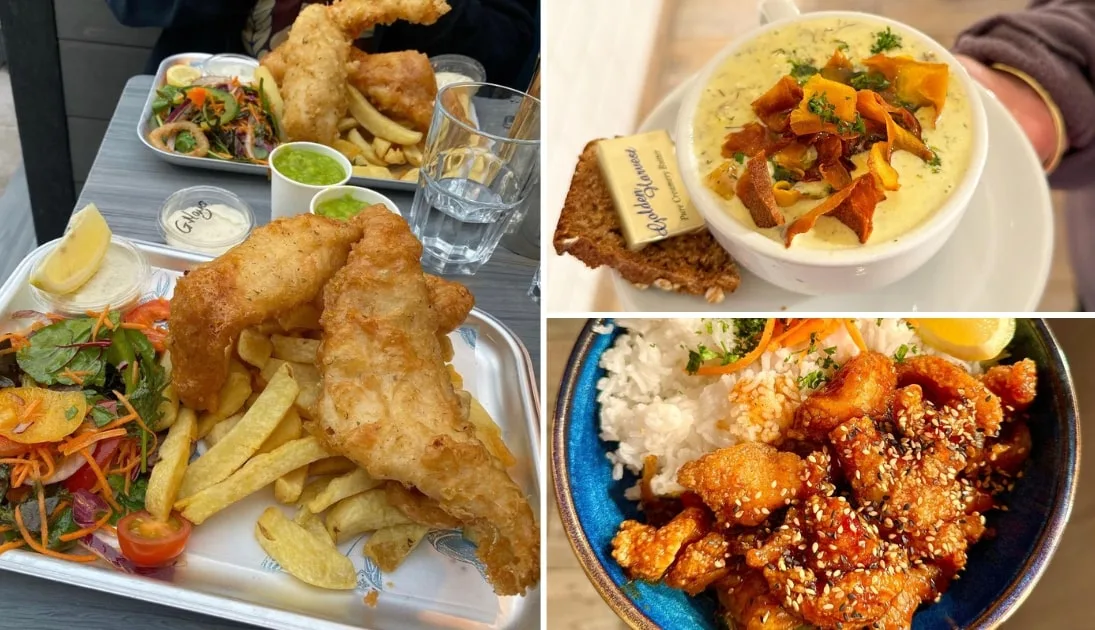
Photos via The Fish Box on FB
Drive around 13 minutes to get back to Dingle, where you’ll be enjoying dinner for the evening. Dingle is a great town for fresh delicious seafood, and you’ll be spoiled for choice when it comes to restaurants.
A few that we recommend are Fish Box (check out their hake burger and fish tacos), The Chart House (a Michelin Guide restaurant serving Irish cuisine), and James Long Gastro Pub (a traditional pub serving local favourites, pizzas, and light bites).
Stop 17: Kenmare for the night

Photo left: The Irish Road Trip. Others: Shutterstock
Head back to Kenmare for your last night in Ireland. The drive takes around an hour and 40 minutes.
Our Kenmare pub recommendations
For after-dinner drinks head to PF McCarthys, Crowley’s Bar, or Roughty Bar.
Stick around Crowley’s Bar for music or check out The Coachmans Townhouse.
Day 9: Back to Cork

Photos via Shutterstock
All good things must come to an end, and today you’re driving back to Cork Airport to fly home.
Grab some breakfast at your accommodation before you check out, or find somewhere nearby.
It takes roughly 1.5 hours to drive from Kenmare to Cork Airport. But be mindful of the Cork City traffic around rush hour, as this has the potential to cause delays, so plan accordingly.
And that’s a wrap on this road trip

Photos via Shutterstock
We hope you found the above road trip guide useful. If you have any questions, ask in the comments below and we’ll do our best to help.
Or, if you’d like to browse our other Irish Road Trip itineraries, visit our Road Trip Hub – cheers!
Keith O’Hara has lived in Ireland for 35 years and has spent most of the last 10 creating what is now The Irish Road Trip guide. Over the years, the website has published thousands of meticulously researched Ireland travel guides, welcoming 30 million+ visitors along the way. In 2022, the Irish Road Trip team published the world’s largest collection of Irish Road Trip itineraries. Keith lives in Dublin with his dog Toby and finds writing in the 3rd person minus craic altogether.

